Having spent one day exploring Guam and a brief overnight on Chuuk, it was now time to embark on the next leg of the journey: a full day on the island of Pohnpei, followed by the rest of the Island Hopper onwards to Honolulu.
United Flight 133: Chuuk to Pohnpei
Unlike the previous two legs, I wasn’t able to snag a business class upgrade for this flight, so instead I got myself the next best thing: an entire row of economy class seats to myself! I took up residence in the window seat, eager to take in some of the ocean views during the first daytime flight of the journey.
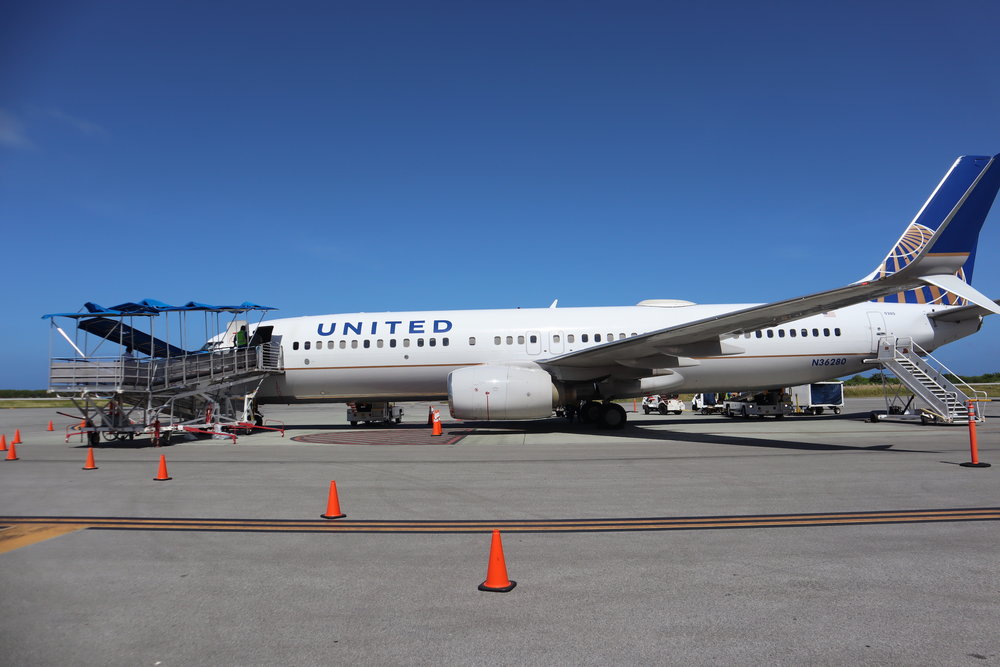
United Flight 176
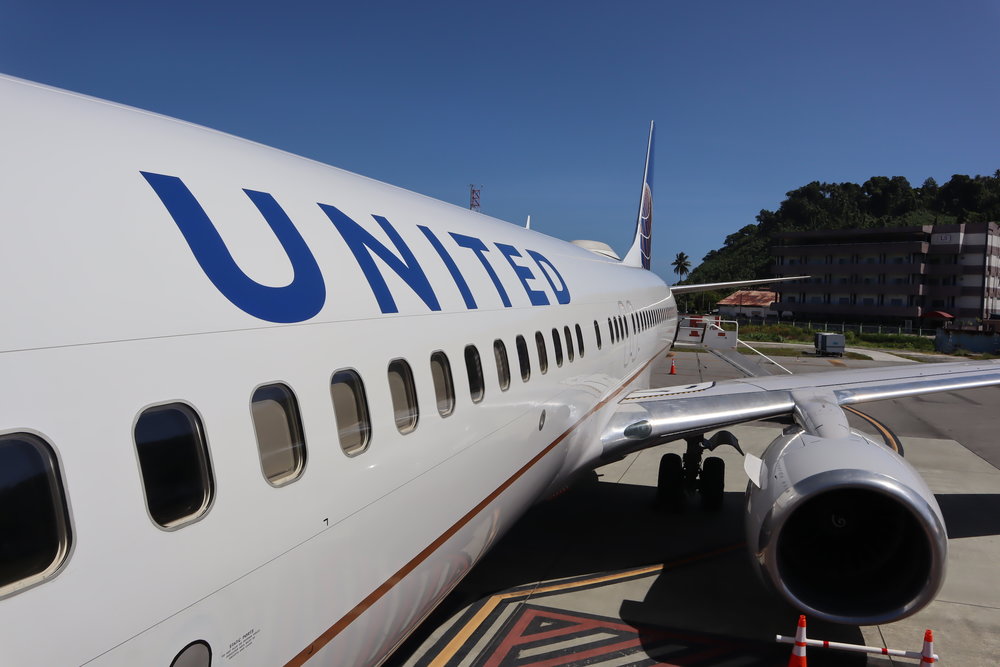
United Flight 176
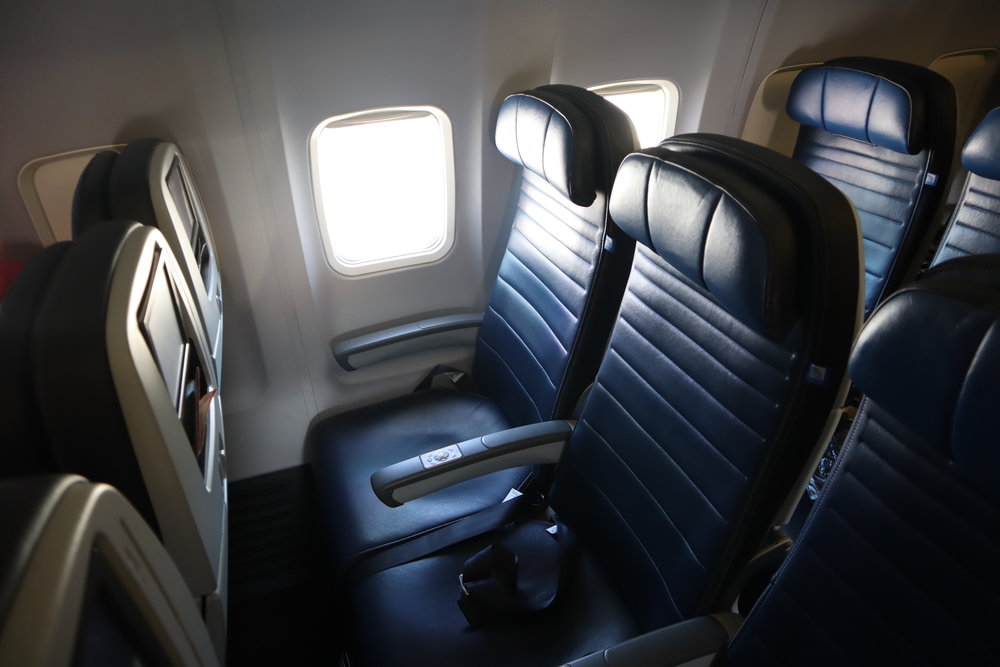
United 737 economy class – Seat 27F
The plane was a little less than half full for this one-hour inter-island hopper flight. This was my third time watching United’s globally-themed safety video in quick succession, and it was just starting to get tiresome.
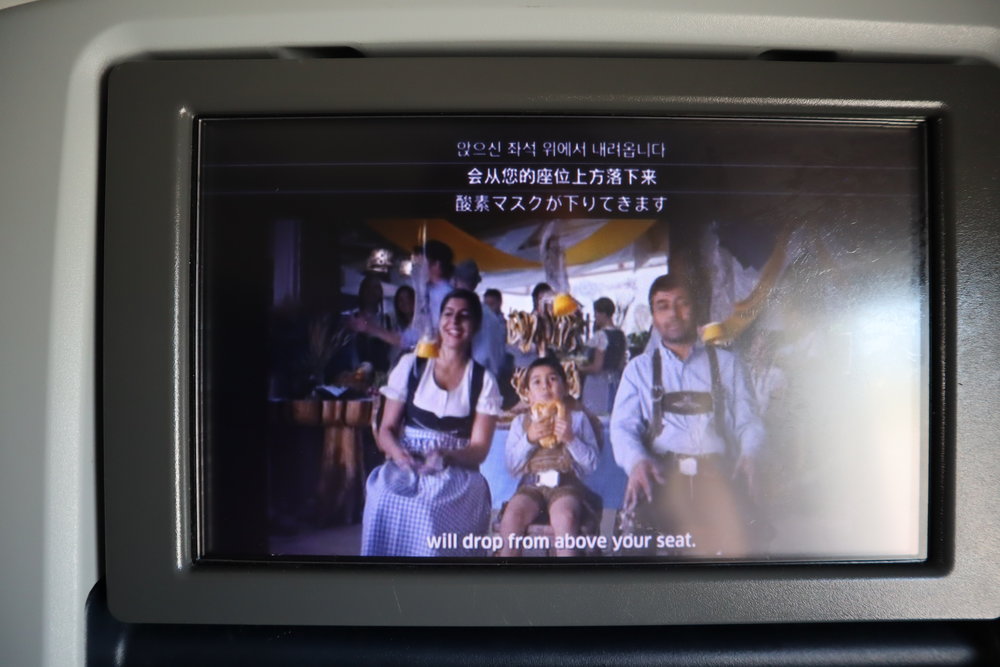
United 737 economy class – Safety video
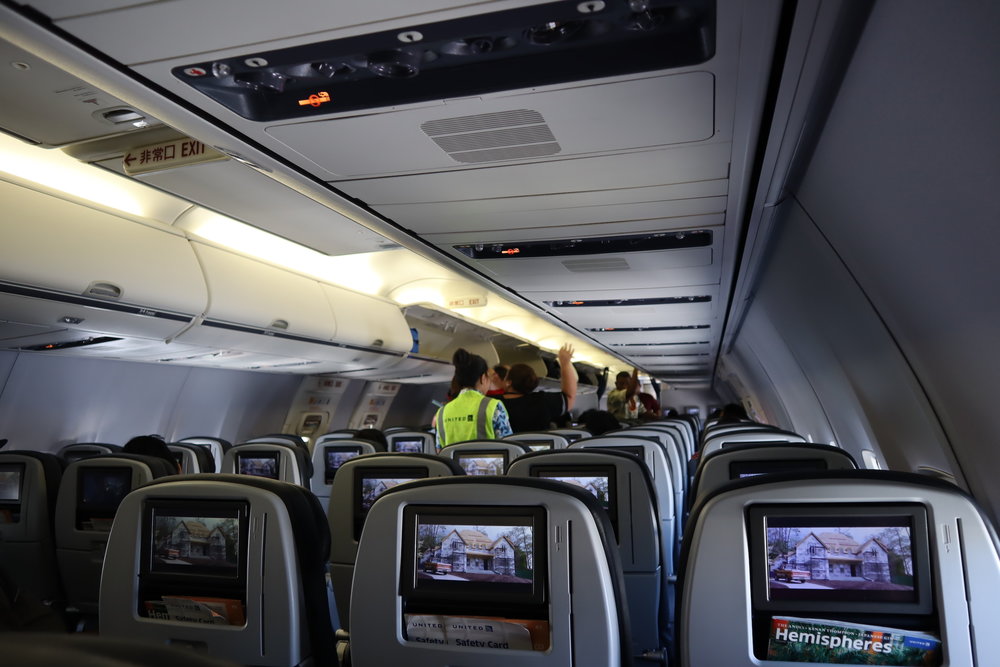
United 737 economy class – Cabin
Fortunately, the window views provided much better entertainment. Chuuk is surrounded by a shallow lagoon filled with outlying islands in the distance, which made for some absolutely breathtaking views upon departure. Meanwhile, the signature deep blue wingtip of United Airlines, with the lone golden stripe, was about to become a very good friend of mine over the next few takeoffs and landings.
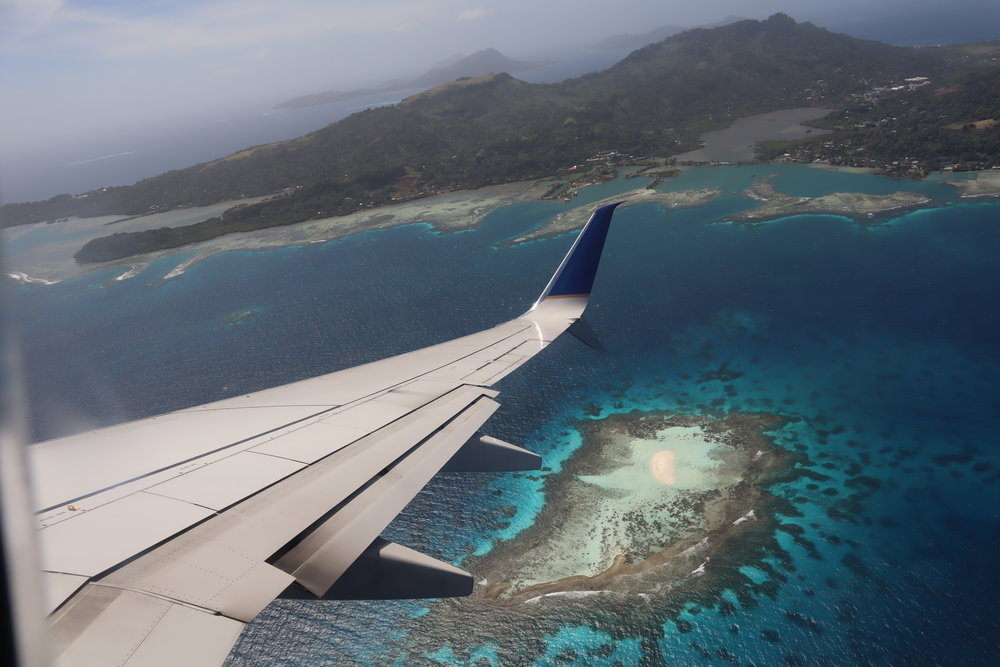
Views of Chuuk Lagoon upon takeoff
(By the way, I had chosen to sit along the right side of the plane for all the daytime flights, since that gives you the best takeoff and landing views on the eastbound Island Hopper. If you were making the journey in the westbound direction from Honolulu to Guam, you’d opt to sit on the left side of the plane instead.)
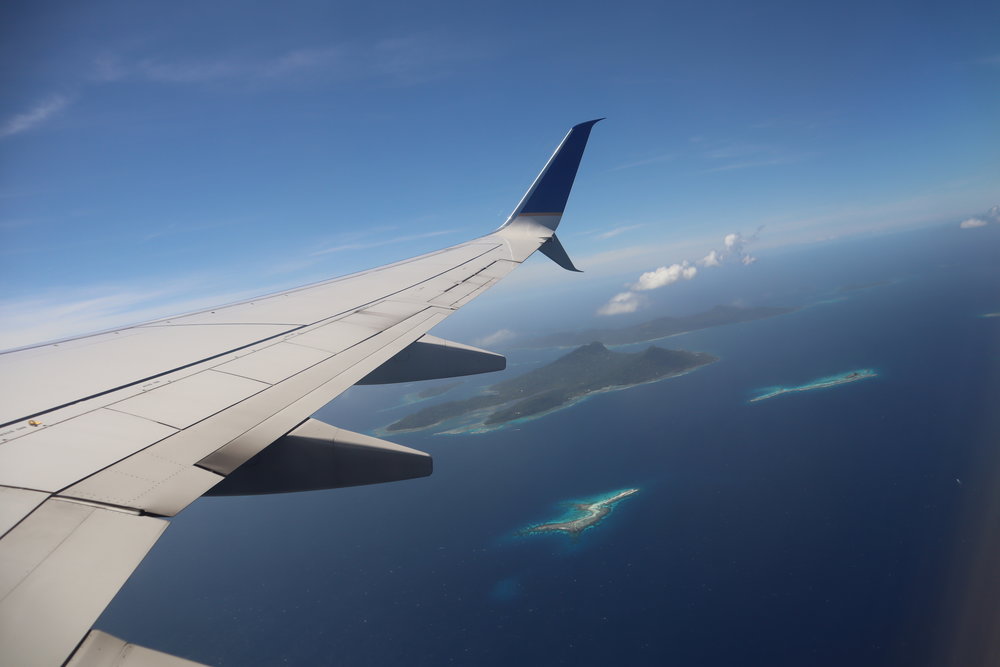
Views of Chuuk Lagoon upon takeoff
The flight passed pretty quickly, and I spent most of the time with my eyes glued to the window, taking pictures of the occasional islet or atoll that popped up in the vast blue ocean.
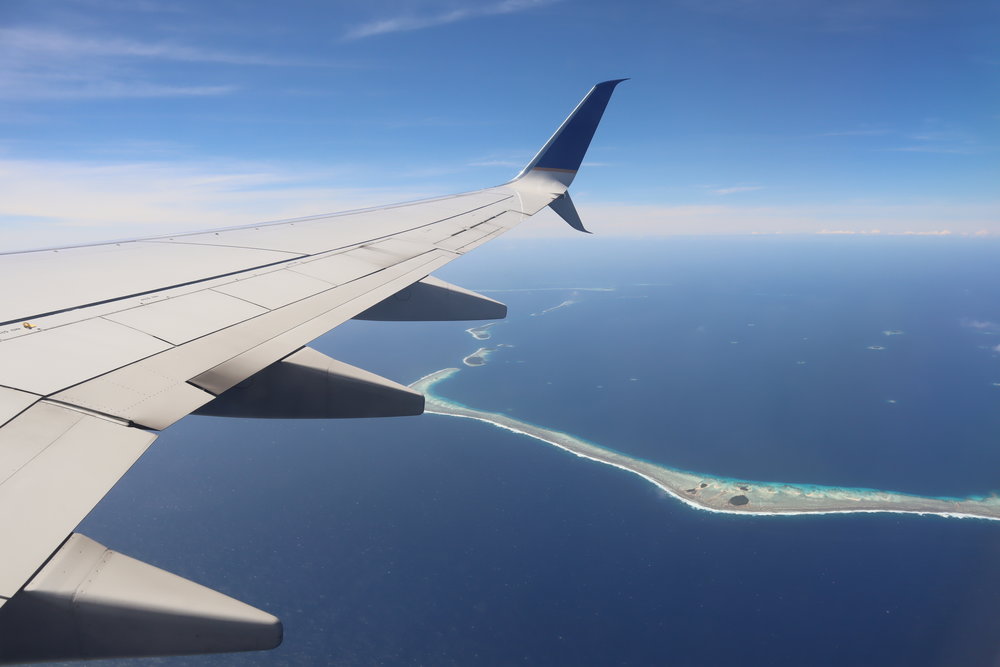
Views of Chuuk Lagoon upon takeoff
Occasionally, I’d glance at the moving map on the entertainment screen, which gave me a stark reminder of where exactly in the world I was.
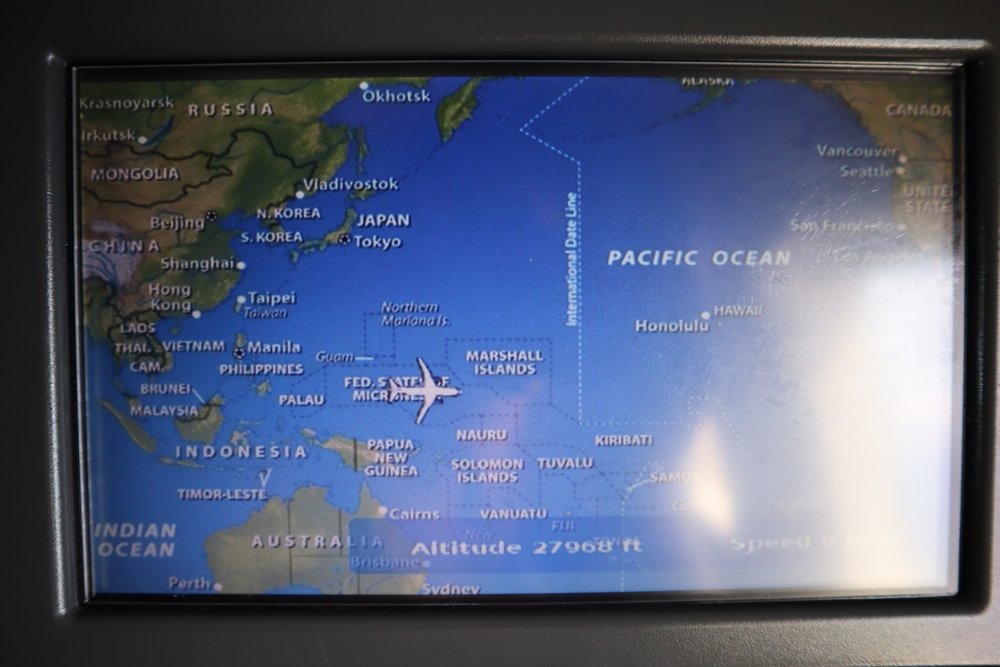
United 737 economy class – Airshow
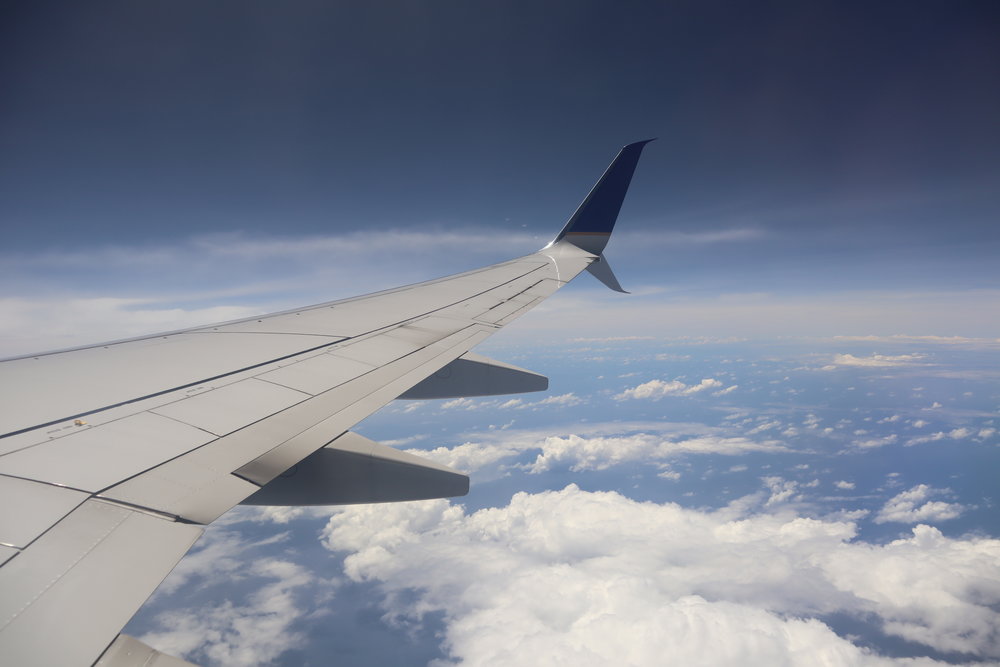
Views of the Pacific Ocean
Economy passengers on the Island Hopper flights are provided with a drink service and a limited buy-on-board menu. I opted for some coffee and water. In addition, I was also handed another Federated States of Micronesia immigration form – each of the FSM’s states runs their own immigration checks, so passengers are still requested to fill in these forms even though Chuuk–Pohnpei is, technically, a domestic flight within the FSM.
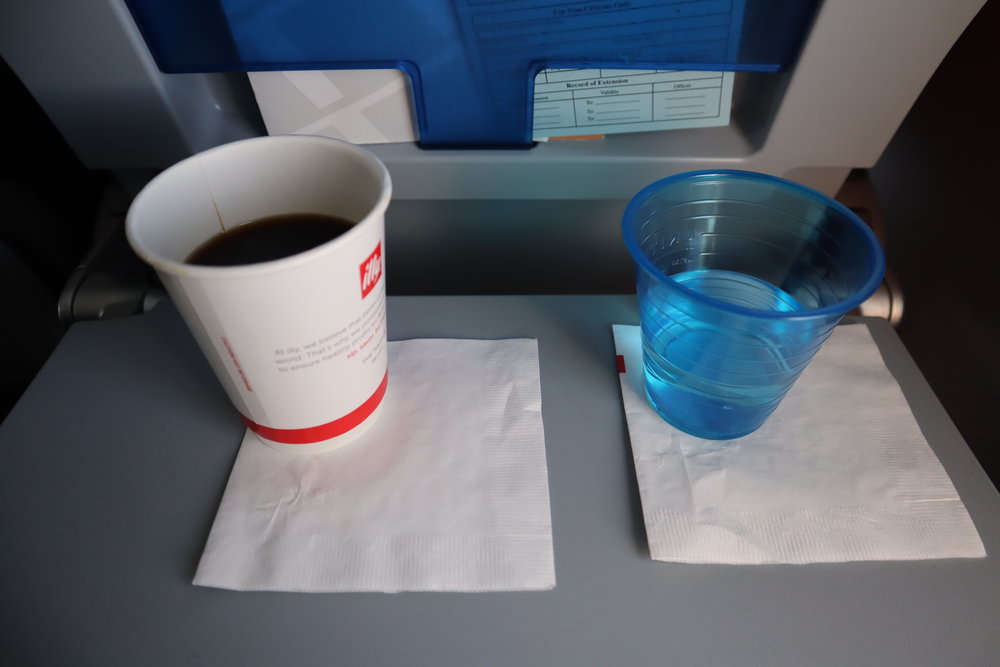
United 737 economy class – Drink service
The skies turned from blue to grey as we approached Pohnpei. A storm was a-brewin’ here on Micronesia’s largest island – certainly not a rare occurrence, for Pohnpei is one of the world’s rainiest inhabited places.
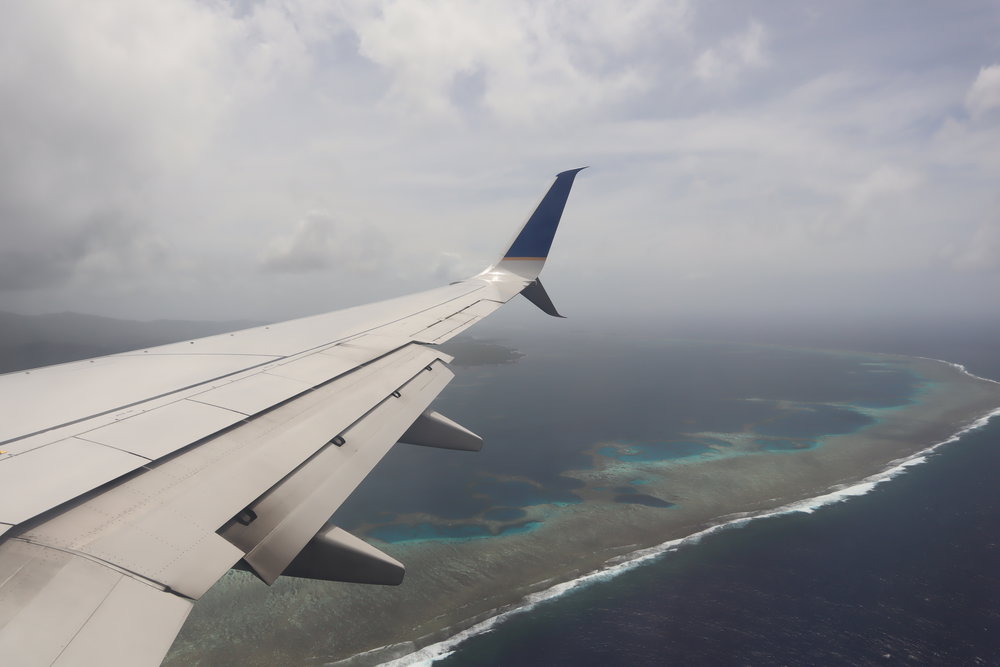
Views on approach to Pohnpei
Similar to Chuuk, Pohnpei is also surrounded by a lagoon (although a much smaller one), with reefs surrounding the island keeping the roiling waves of the Pacific Ocean at bay.
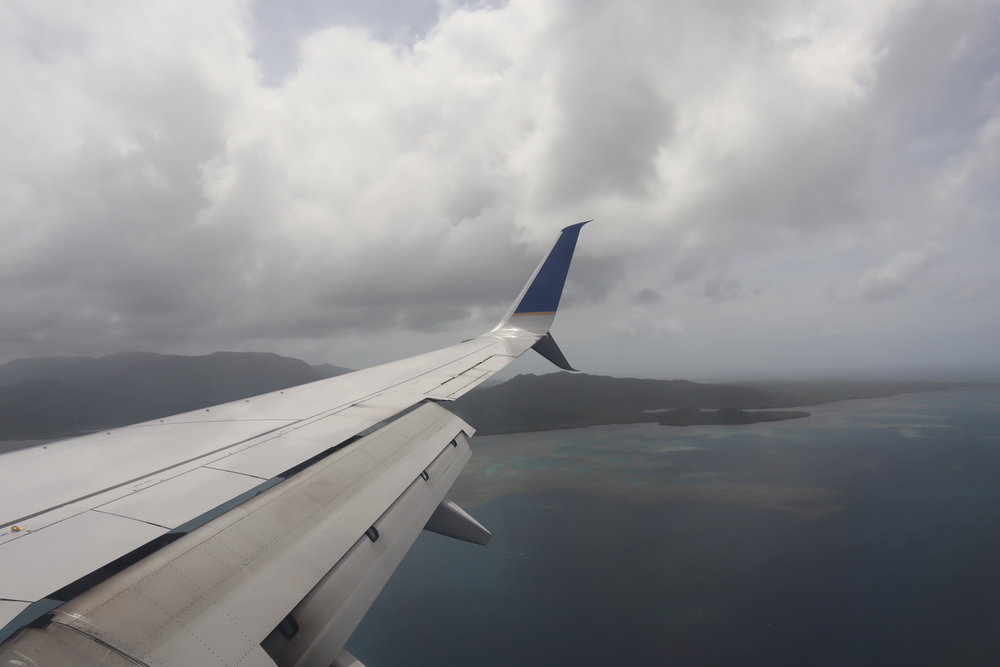
Views on approach to Pohnpei
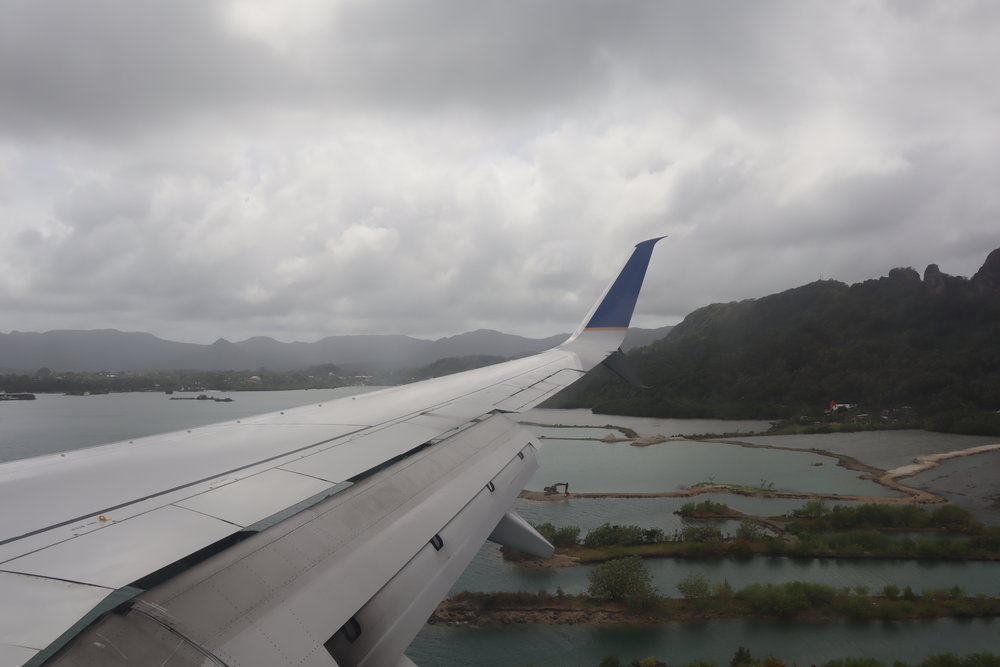
Views on approach to Pohnpei
Meeting My Guardian Angel
Upon landing in Pohnpei, I grabbed my bags and walked out aimlessly into the open, expecting to hail a cab to bring me to my hotel. Instead, I was approached by a kind American fellow who would turn out to be my guardian angel during my time on Pohnpei: Mr. Joe Daisy, the President of the College of Micronesia.
It turns out that Joe has been working here on Pohnpei for eight years now, and he quite enjoys helping out any travellers who happen to make it out to this part of the world. Seeing that I was obviously a clueless tourist, Joe offered to give me a ride to my hotel, and perhaps even show me around the island a bit.
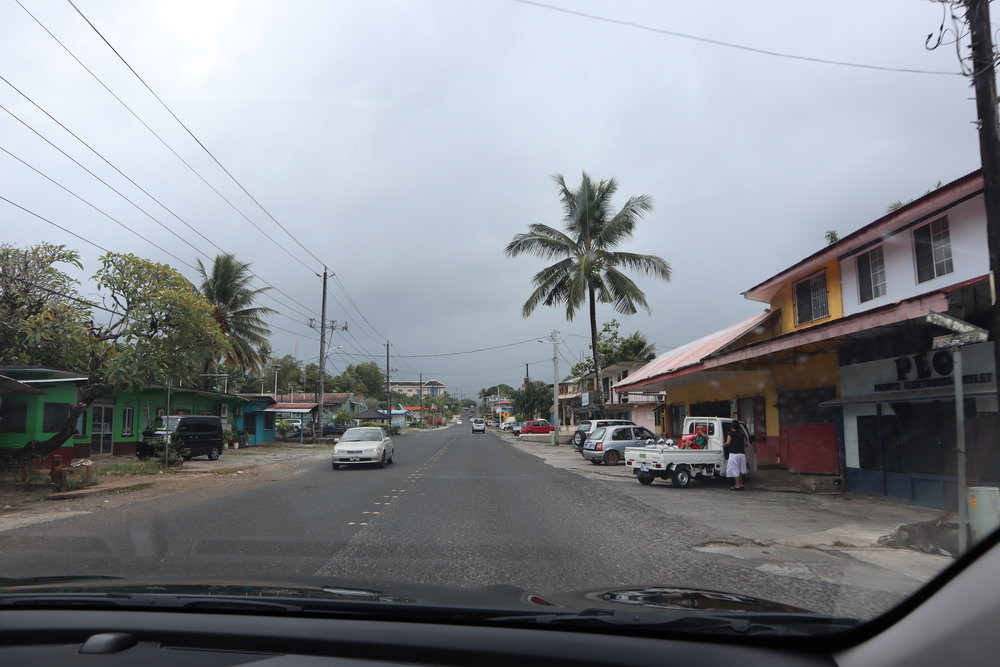
Driving in Kolonia, Pohnpei
We first drove down to Mangrove Bay, a popular spot by the water not too far from my hotel. Right away, it was clear that Pohnpei was significantly more developed than Chuuk: the roads were in much better condition, the buildings didn’t look to be falling apart, and there were actually quite a handful of established businesses operating in Kolonia, the main town next to the airport and where I’d be staying for the night.
People who arrive in Pohnpei by sailboat usually dock here at Mangrove Bay, and there’s a small bar and a hotel – the Mangrove Bay Hotel, which seems quite popular with tourists – located here as well.
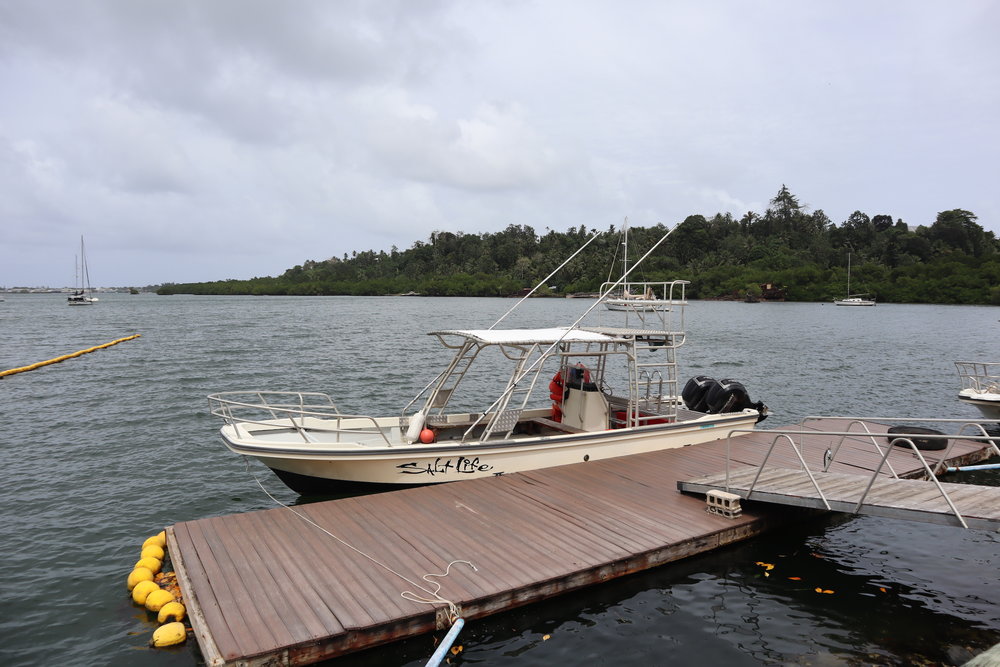
Mangrove Bay, Pohnpei
After snapping a few pictures of Mangrove Bay, which was one of the more significant points of interest in the immediate area but was otherwise quite nondescript, we began driving back towards Kolonia… but then Joe asked me if I’d like to check out Palikir, the FSM’s capital, as well.
I wanted to make sure I wasn’t troubling Joe too much, but he insisted he had some spare time, and so we began the 15-minute drive over to Palikir.
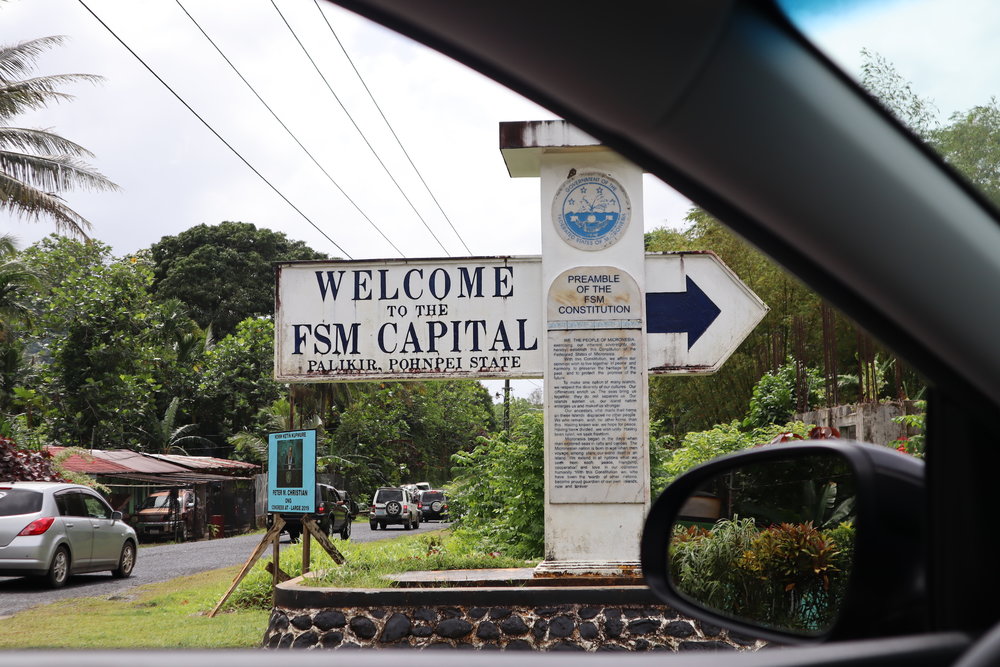
Driving to Palikir, Pohnpei
Along the way, we got to chatting about what life was like for him as an expatriate here on the FSM. Joe has working as an educator out here for eight years, and only goes back to the continental US a few times a year, so he’s gotten pretty used to the “island life” – it’s extremely isolated from the outside world, yes, but it’s also a very uniquely peaceful life that not many people get to enjoy.
Arriving at Palikir, I got to check out the Federated States of Micronesia’s federal buildings, congress chambers, and Supreme Court. Few other capital cities around the world can rival Palikir in terms of laid-backness, that’s for sure.
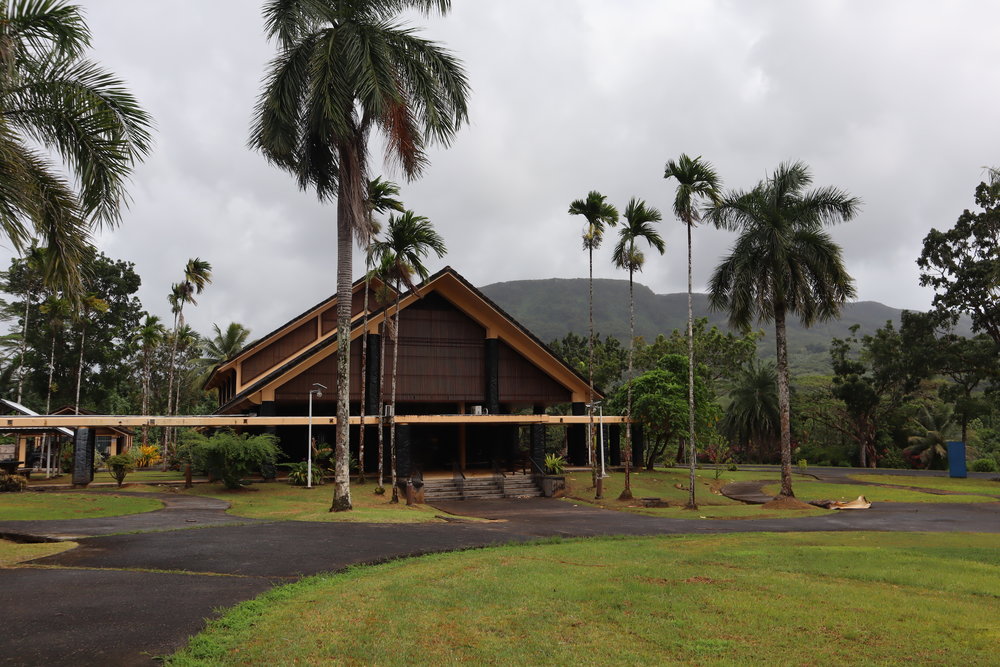
Federated States of Micronesia Supreme Court
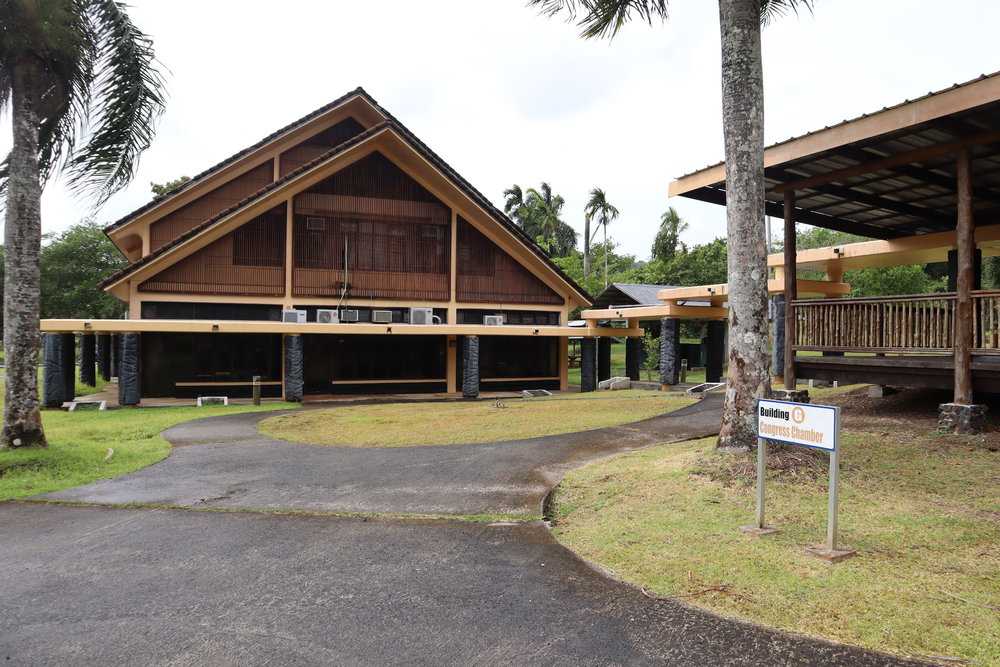
Federated States of Micronesia Congress Chamber
I even got to peek through the windows to see the inside of the official FSM congressional chamber, where representatives from Yap, Chuuk, Pohnpei, and Kosrae come together to discuss matters on a national level.
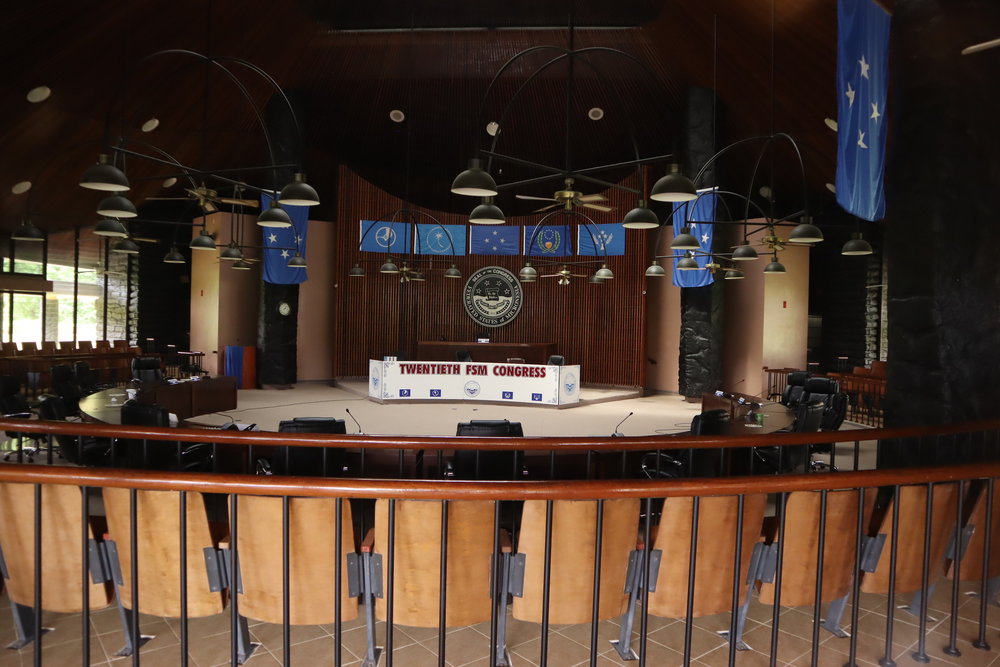
Federated States of Micronesia Congress Chamber
We then drove to the College of Micronesia, which is the country’s foremost higher education institute, where Joe serves as the President. I didn’t get a chance to step outside, but Joe drove me around to give me a look at all the buildings, including the decorative canoes and huts that represented each of the FSM’s constituent states.
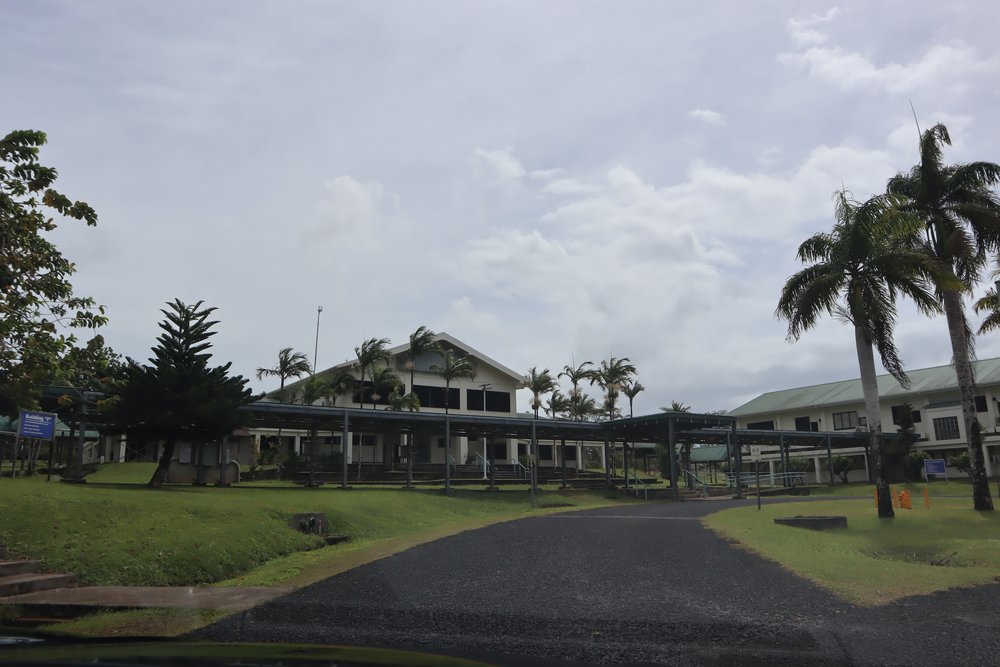
College of Micronesia
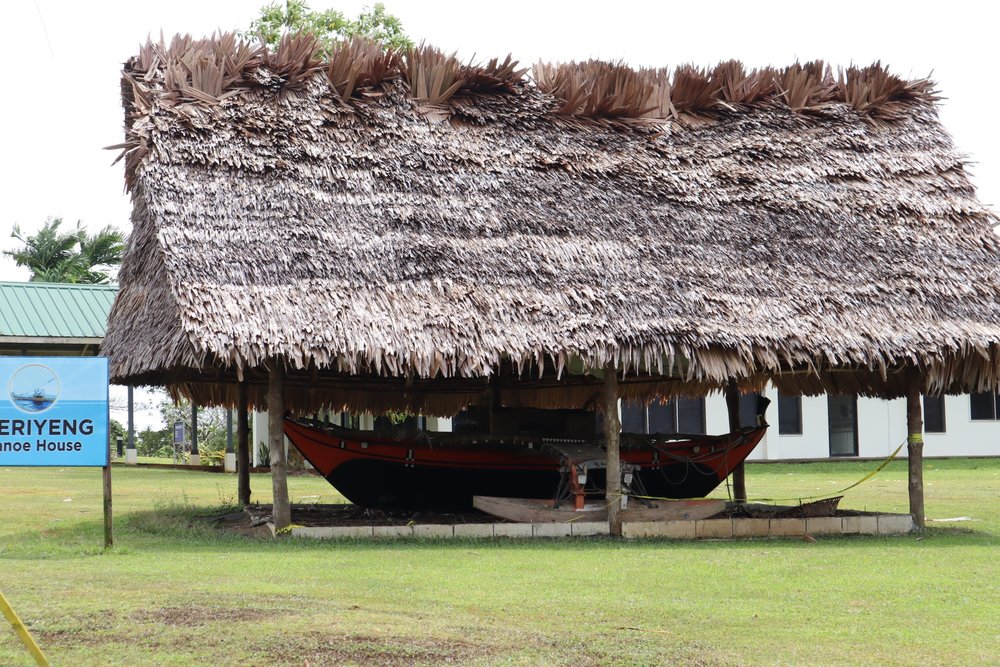
College of Micronesia – Traditional canoe house
(While Yapese, Chuukese, Pohnpeian, and Kosraean students each built a hut in their respective islands’ traditional styles, a fifth hut was contributed by students from Pingelap, which is an island within Pohnpei State. Pingelap is the island where, famously, a huge portion of residents suffer from total colour blindness as a result of a common ancestor who possessed the trait many generations ago. I would’ve loved to visit Pingelap on this trip, but alas, I’ll have to save it for next time!)
Soon it was time to begin the drive back to Kolonia. Along the way, Joe pointed out the various new facilities that had been built here on Pohnpei, most of which were the result of foreign aid – China built them a new stadium, the US gave them a new greenhouse, Japan built a school, etc.
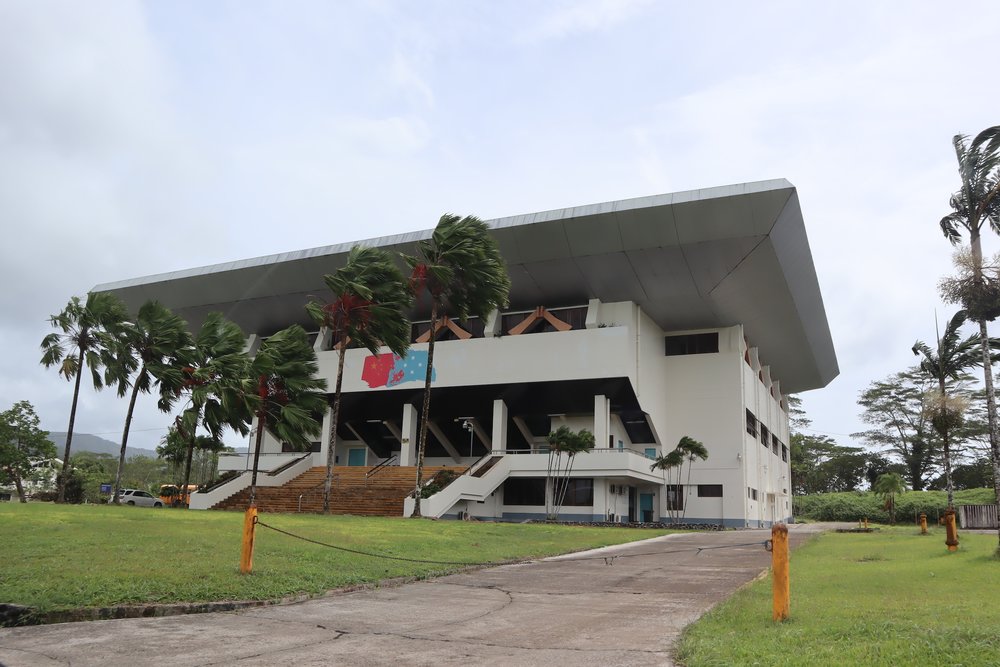
Stadium built by China
I asked Joe why Pohnpei was so much more developed than Chuuk, and the answer relates to the islands’ respective histories.
The Pohnpeian people settled into a hierarchical society very early on – indeed, the ruins of Nan Madol, which I’d visit the next day, were once the seat of the ancient Saudeleur Dynasty way back in 1100, the island’s first form of organized government. This allowed Pohnpeians to live prosperously, even as the Saudeleur rulers were later replaced by a more decentralized system of tribal chiefs.
Conversely, Chuukese society was traditionally broken down into several warrior tribes that were constantly at loggerheads with one another over the centuries. As a result, civil society never truly materialized on Chuuk until very recently, and its state government continues to struggle with internal conflict, leaving the island lagging behind significantly in terms of development.
There was much to contemplate as Joe brought me back to Yvonne’s Hotel, where I’d be staying for the night.
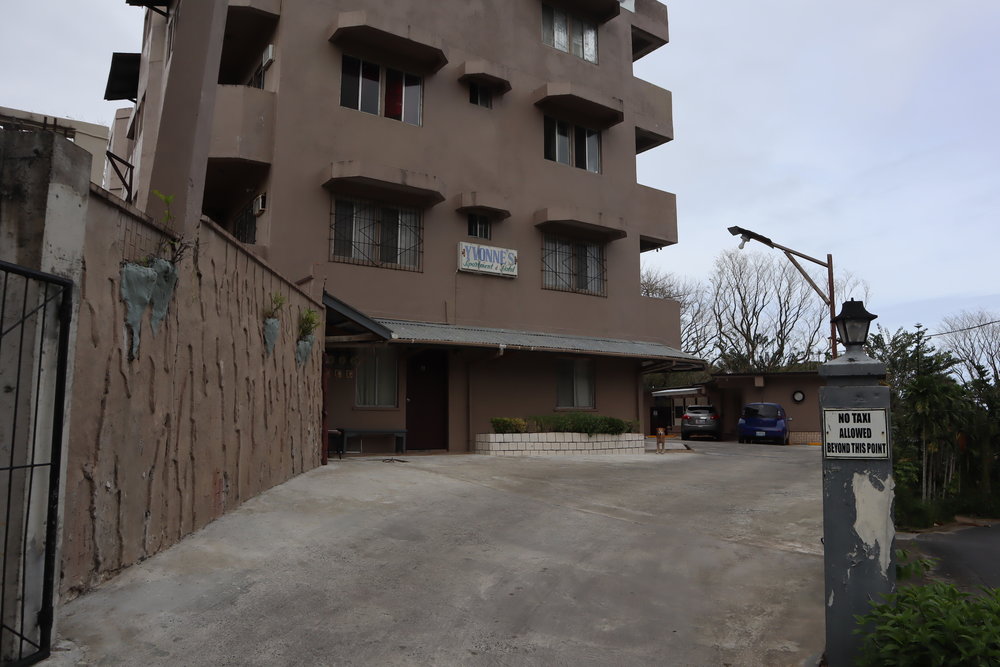
Yvonne’s Hotel
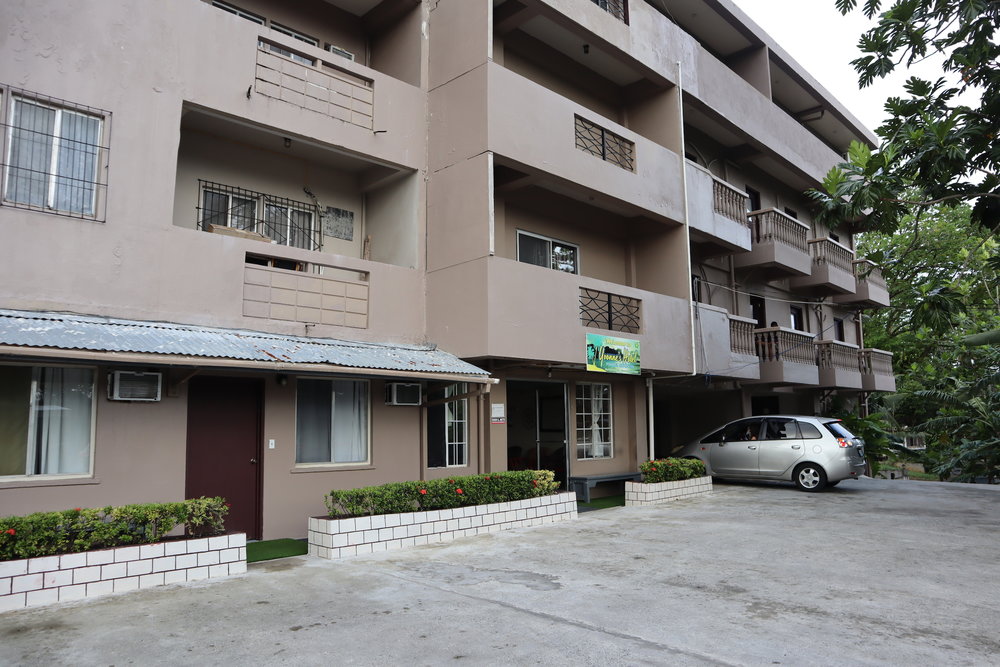
Yvonne’s Hotel
After ensuring that I checked into the hotel smoothly, Joe even asked if I was hungry and brought me down to street to a local restaurant so that I could have lunch. He even went inside to check that they were still open on my behalf!
Needless to say, I was exceedingly grateful to Joe for all the help he had given me, and I thanked him effusively as we parted ways.
If anyone is planning a trip to Pohnpei, get in touch with me and I can pass along Joe’s contact information. If he’s free, I’m sure he’d be happy to show a fellow traveller around the island!
A Relaxing Evening
Anyway, I sat down for lunch at the local restaurant, and I picked a spot on the outdoor patio overlooking the busy waters of the lagoon. Lunch was served buffet-style, so I grabbed myself a healthy portion of tuna sashimi, along with some chicken, rice, and egg drop soup.
(The four constituent states of the FSM are spread out over thousands of miles of the Pacific Ocean, giving the country a vast area of exclusive fishing rights. As a result, tuna sashimi is fresh and cheap, which was something I was very happy to discover!)
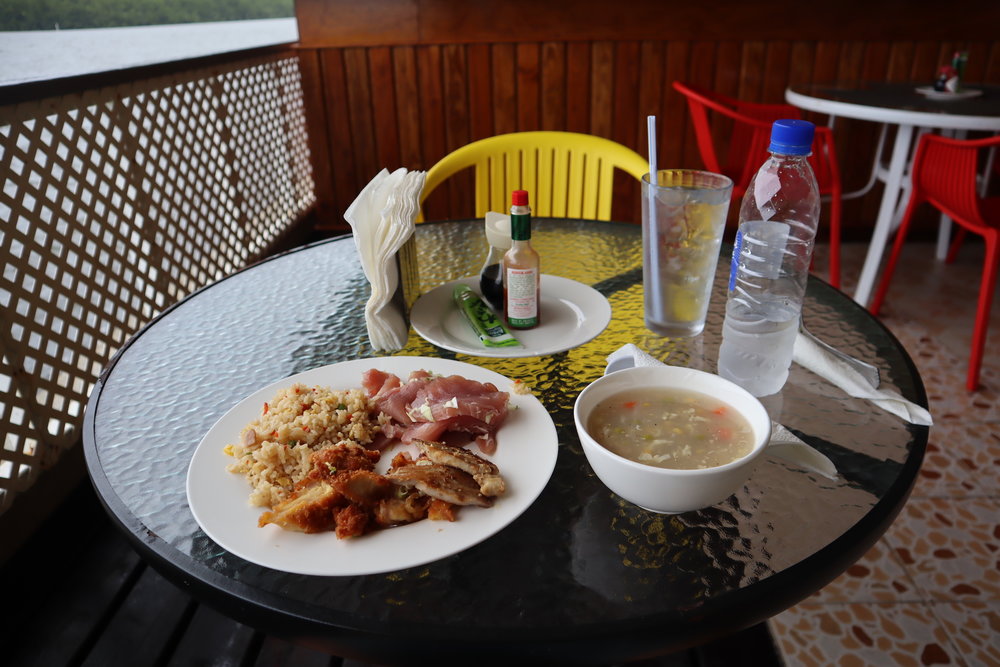
Lunch in Pohnpei
After lunch, I walked back to the hotel, where I decided to take it easy for the rest of the day, since I was pretty exhausted and I’d be embarking on an excursion out to Nan Madol the next morning.
I had been assigned Room A here at Yvonne’s Hotel, which was extremely bare-bones. There was a bed, a tiny TV (which I didn’t bother turning on), a cabinet, a sink, a fridge, and the toilet and shower.
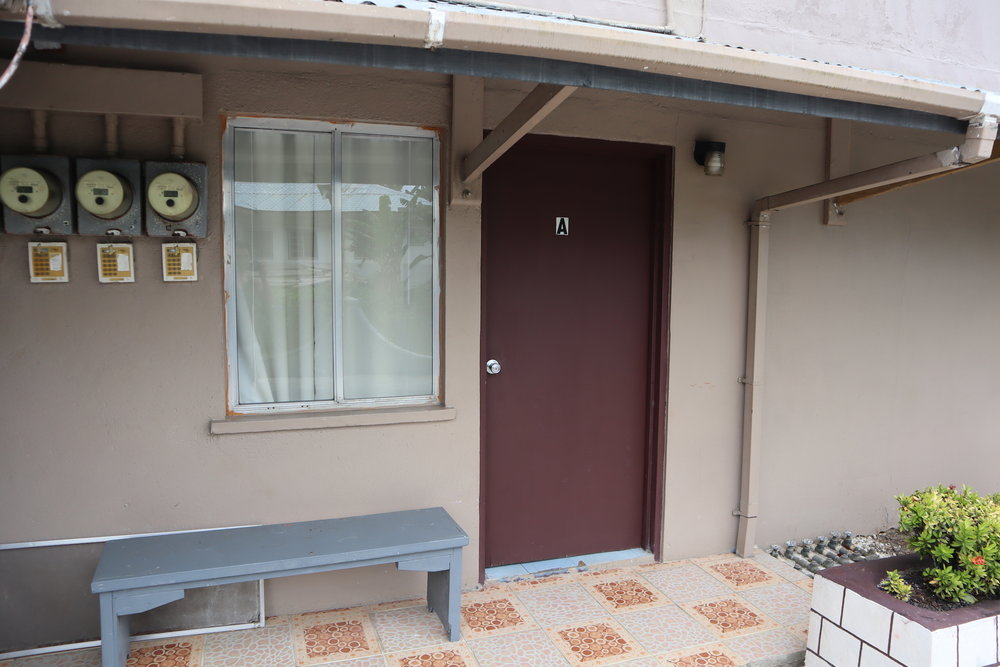
Yvonne’s Hotel – Room A
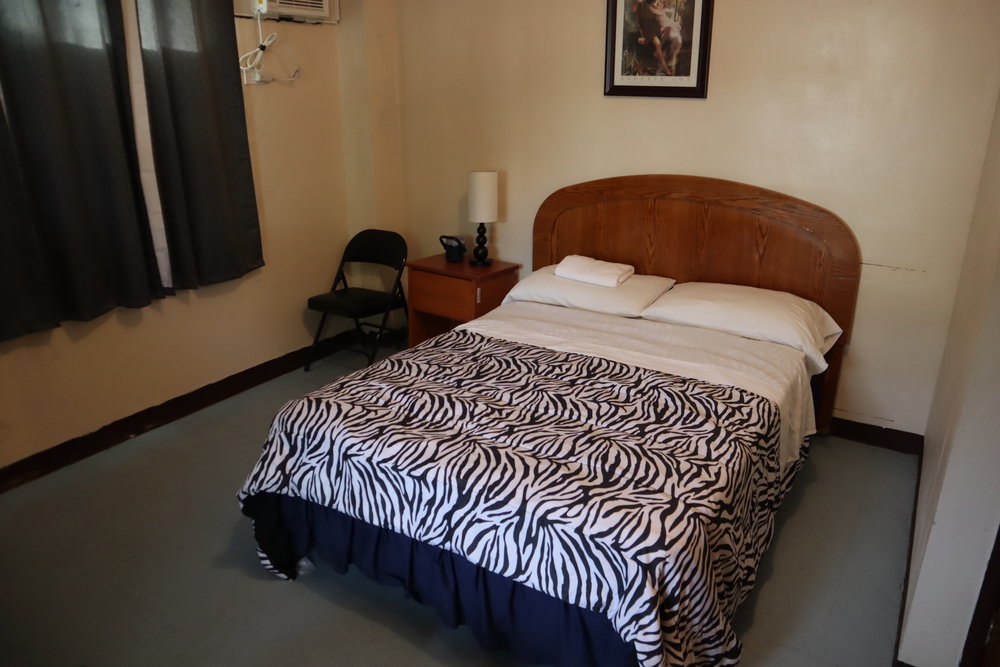
Yvonne’s Hotel – Room A bedroom
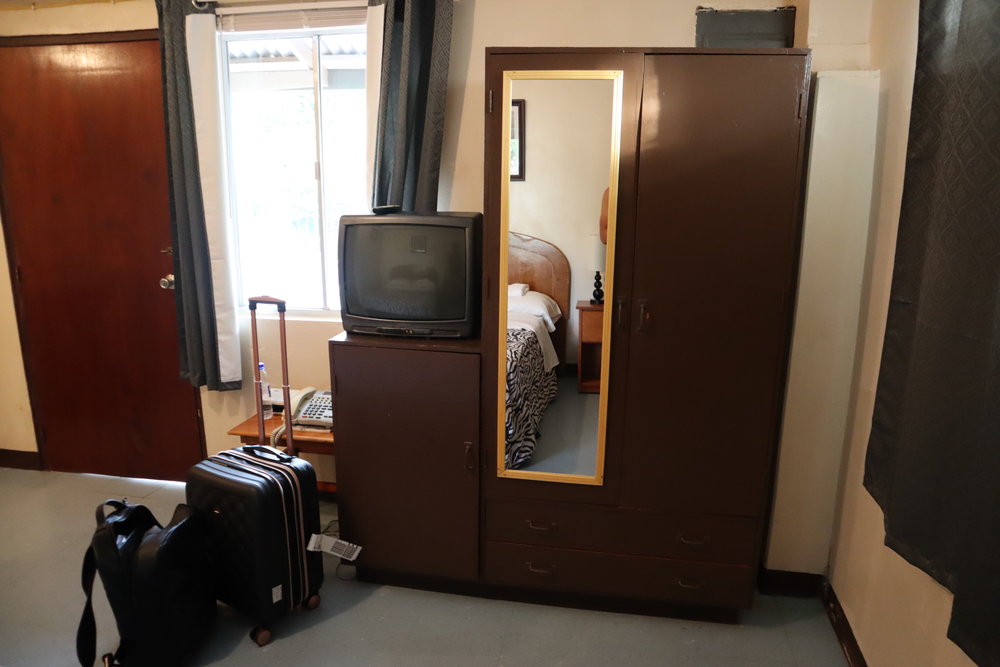
Yvonne’s Hotel – Room A bedroom
I left my belongings in the room, and mostly spent my time doing some work on my laptop from the lobby, which was the only place where wifi was accessible.
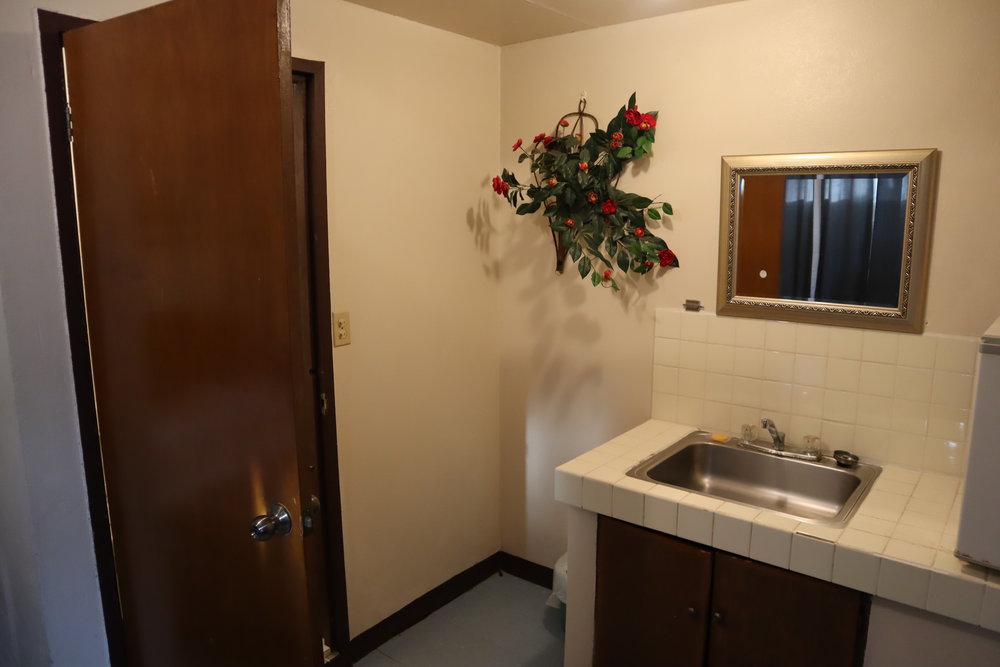
Yvonne’s Hotel – Room A countertop
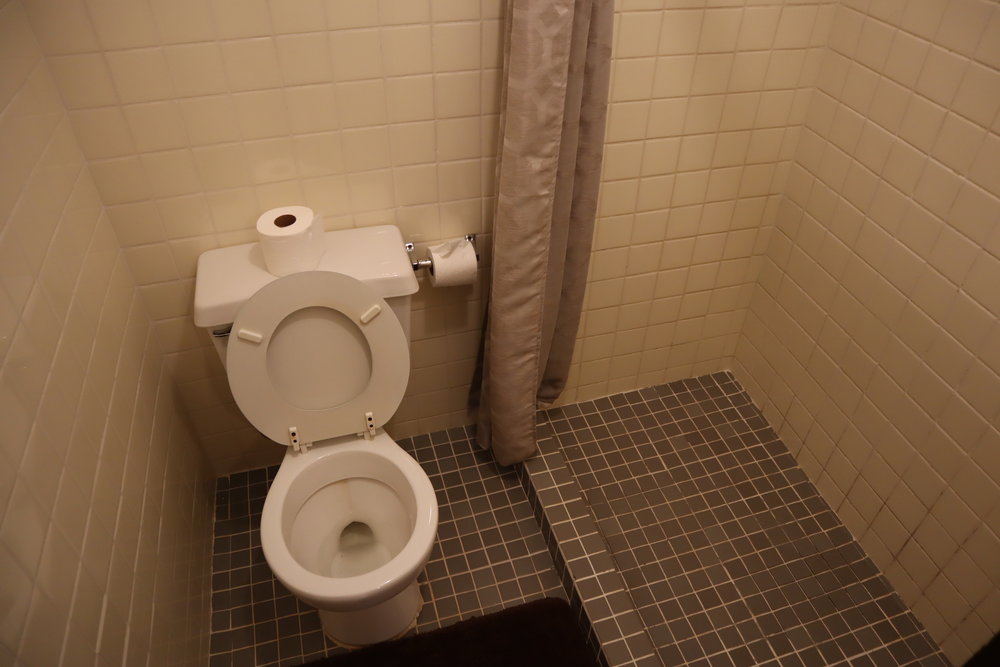
Yvonne’s Hotel – Room A bathroom
At around 8pm, I headed to the hotel restaurant for some dinner. A large plate of tuna sashimi for US$11 hit the spot just right, and soon after that, I was back in Room A getting ready for much-needed early night’s sleep.
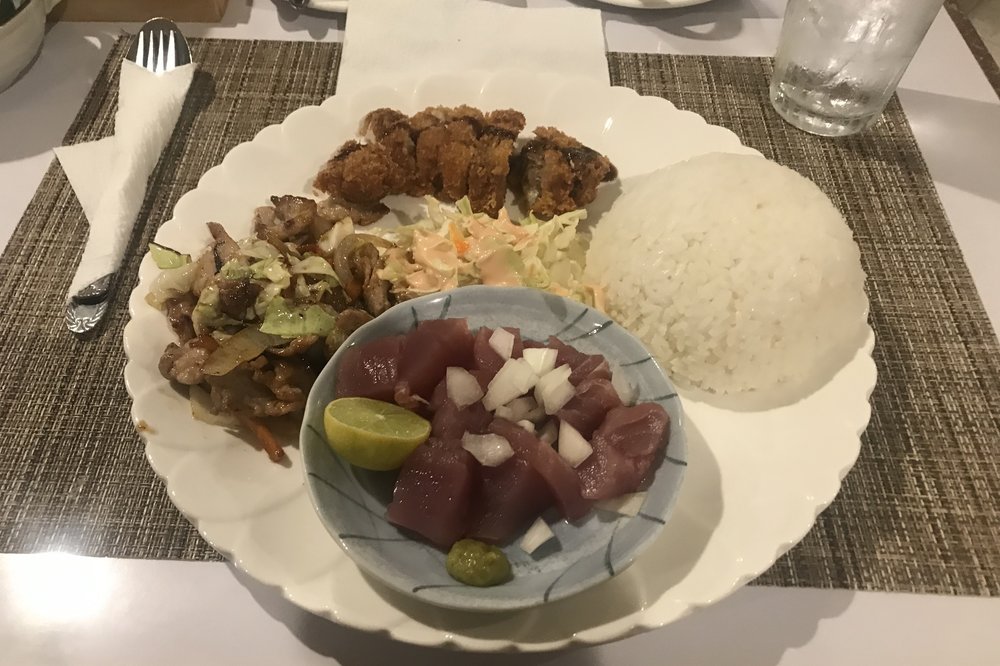
Yvonne’s Hotel – Dinner
Morning Tour of Nan Madol
The next morning, I had a quick breakfast consisting of fried pork cutlets, fried eggs, some salad, two measly half-sausages, and some rice. The breakfast cost me about US$8, and I can’t say there was especially good value for money there.
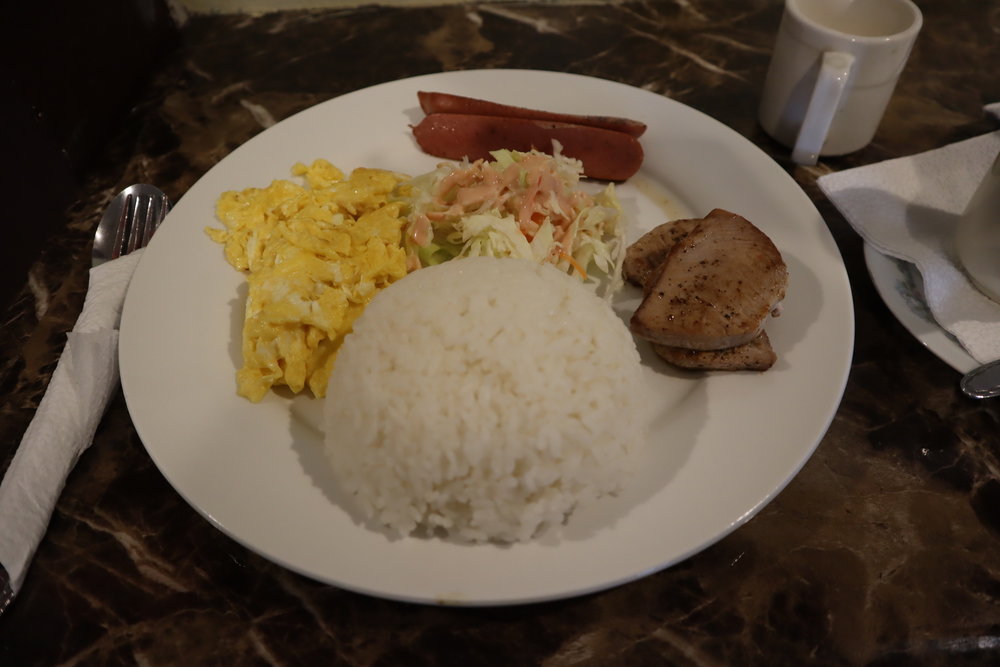
Yvonne’s Hotel – Breakfast
Then it was immediately time to head out to the ruins of Nan Madol. My Island Hopper flight would be departing at 1:44pm, so I needed to be back at the hotel by around noon. That left me with around three hours to make the trip to and from Nan Madol, which the hotel staff had assured me was enough.
By the way, I had paid the hotel around US$55 for a “tour of Nan Madol with a private guide”, but I have to say that “driver” would’ve been a much more apt description than “guide”.
The guy barely spoke a word during the whole drive, and when I asked him about Nan Madol, he managed to utter something along the lines of “It’s very good!” and that was about it.
I also asked him if he was originally Pohnpeian. He replied saying he actually came over from Chuuk (this goes back to what my driver in Chuuk the previous day had said about many Chuukese leaving the island and not coming back). And that was about the extent of our conversation.
For US$55, I felt a little short-changed, but hey, I wanted to see Nan Madol in a very limited window of time, and the price was the price.
Anyway, the drive took about an hour in each direction, and at least the views were pretty scenic. While the main road encircling the island here on Pohnpei is in much better condition than Chuuk’s, it’s still by no means a highway, and so traffic proceeds at a leisurely pace at all times.
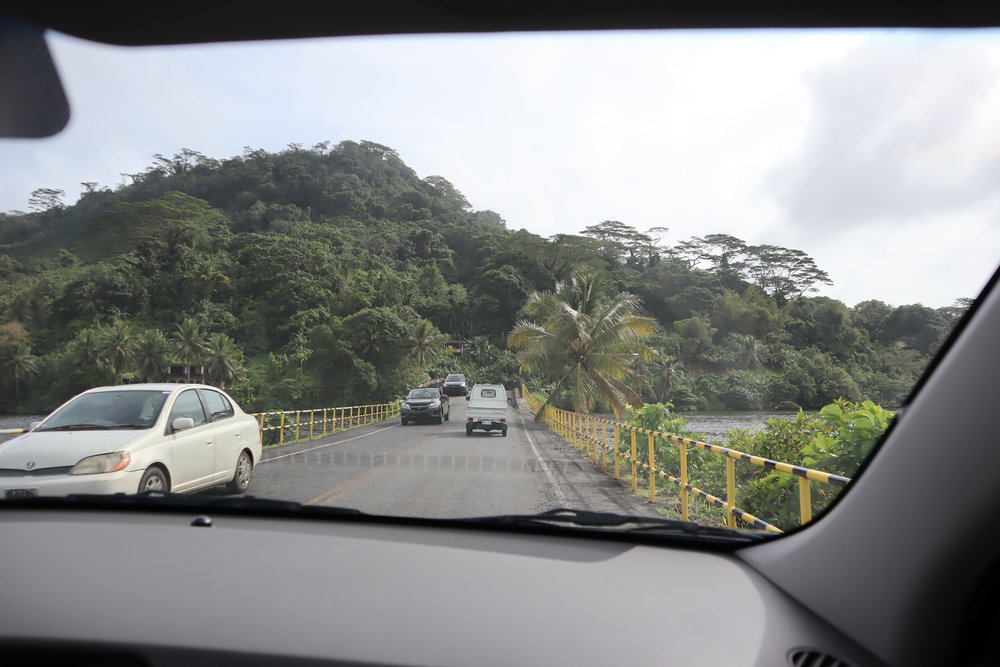
Road to Nan Madol
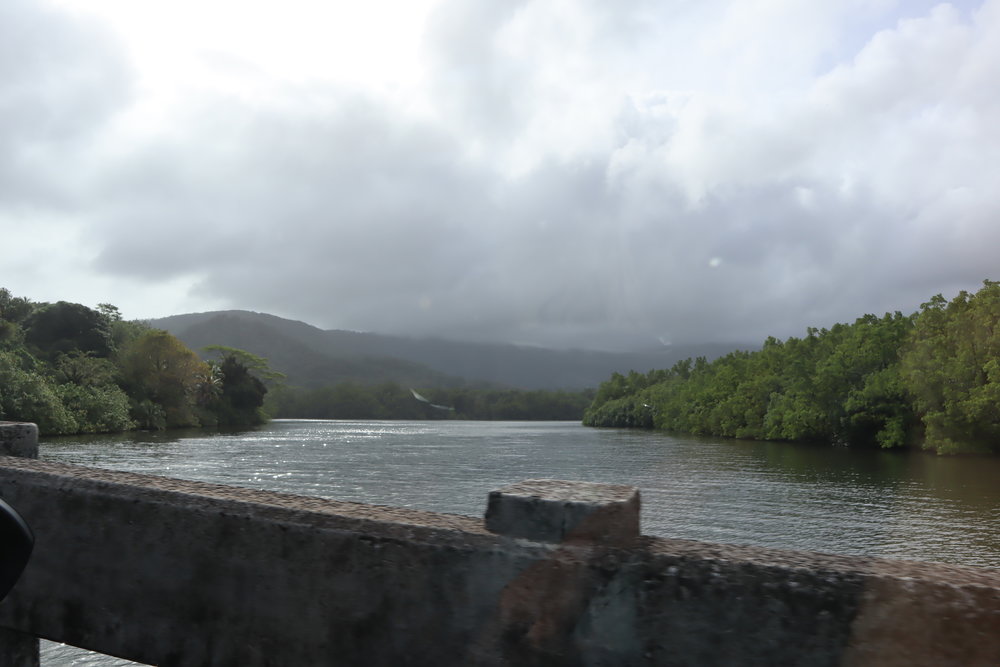
Views along the road to Nan Madol
Finally, we parked the car and started hiking down towards Nan Madol, which rises out of the shallow waters of Pohnpei’s eastern shores down by the coastline.
In addition to driving there, another way to visit Nan Madol is to take a boat and arrive directly at the half-submerged ruins – certainly a worthy goal for next time!
There were a bunch of eerily sharp tree branches protruding from the ground in the woods here, which looked like booby traps and added an “Indiana Jones” element to our brief hike down to the water level. It was an exhilarating feeling!
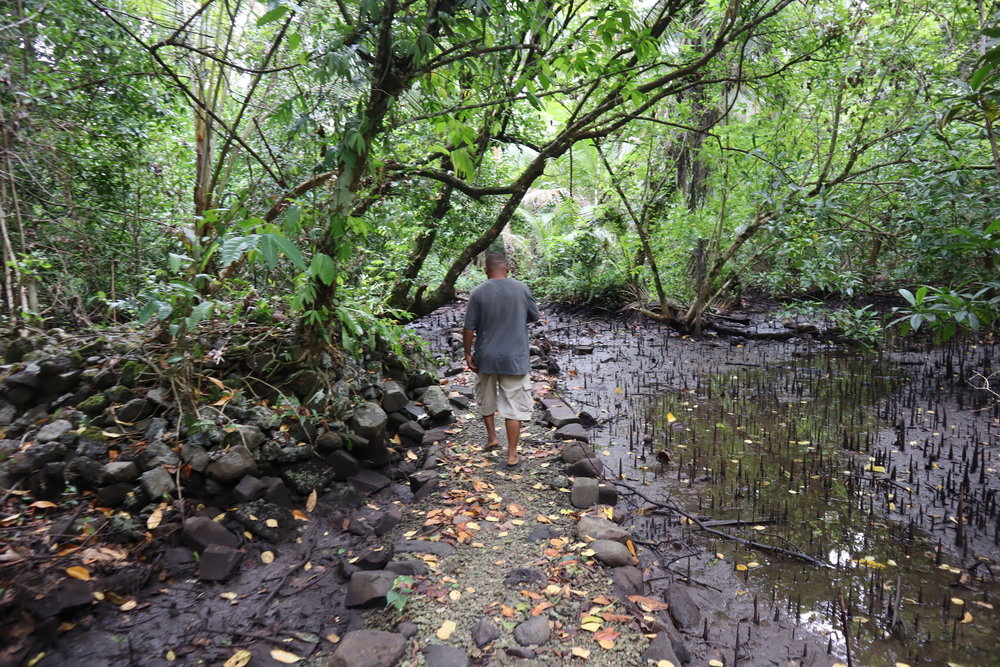
Hiking down to Nan Madol
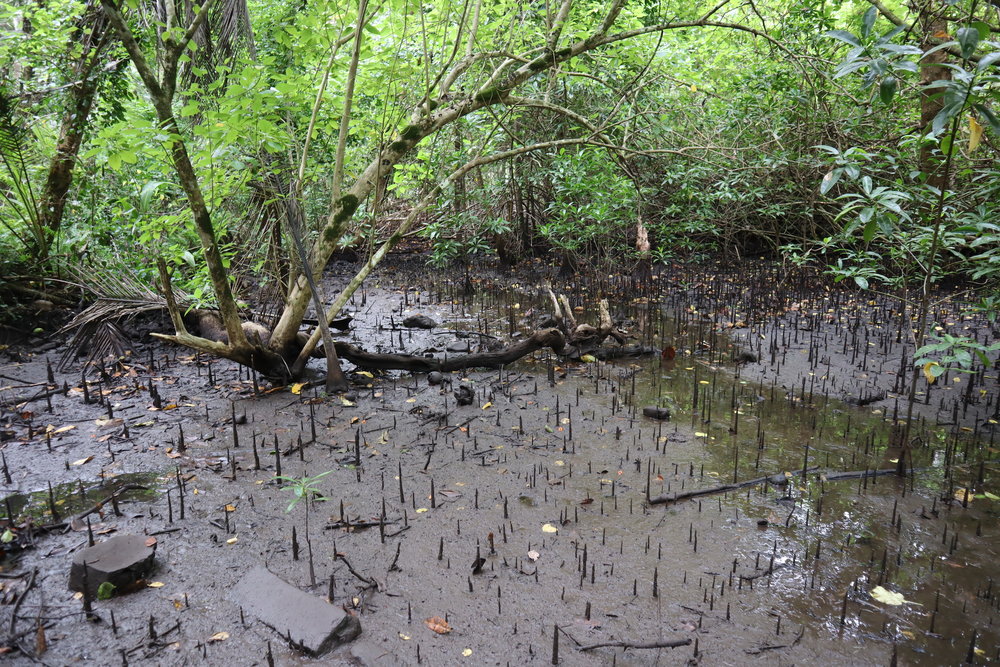
Hiking down to Nan Madol
A few more minutes downhill, and we finally arrived at Nan Madol. The ruins sit across a shallow channel of water, which only adds to the mysteriousness of the place.
My guide invited to cross the channel, where someone was waiting to collect a US$5 “entrance fee” from me. Again, the price is the price, I guess…
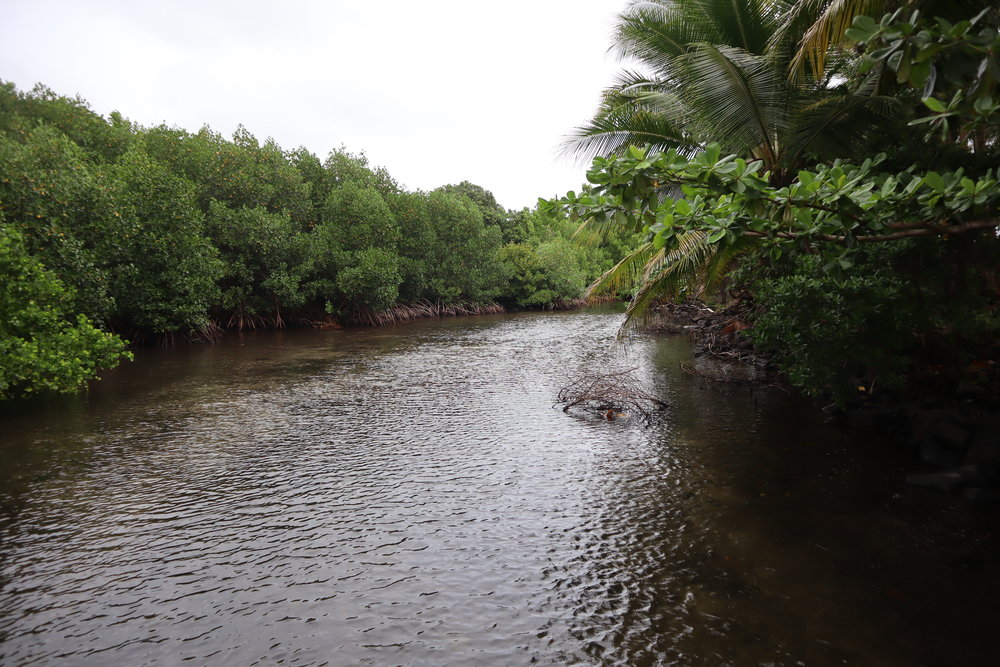
Cross this channel of water…
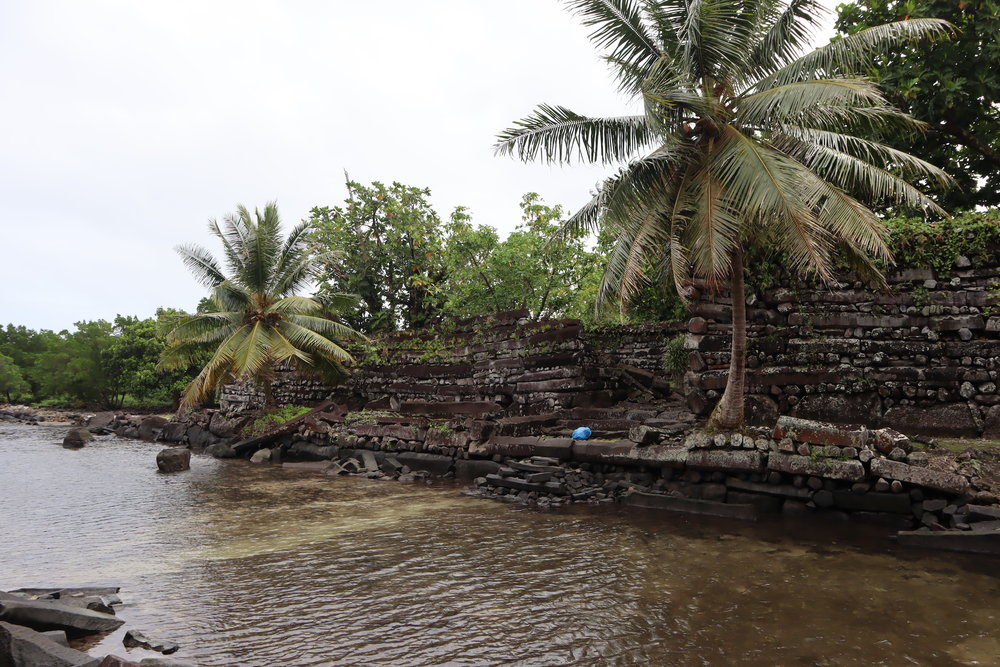
…to arrive at the ancient ruins of Nan Madol.
Then I was left to my own devices to explore Nan Madol. This place is a source of great confusion among modern archaeologists, and it’s not hard to see why.
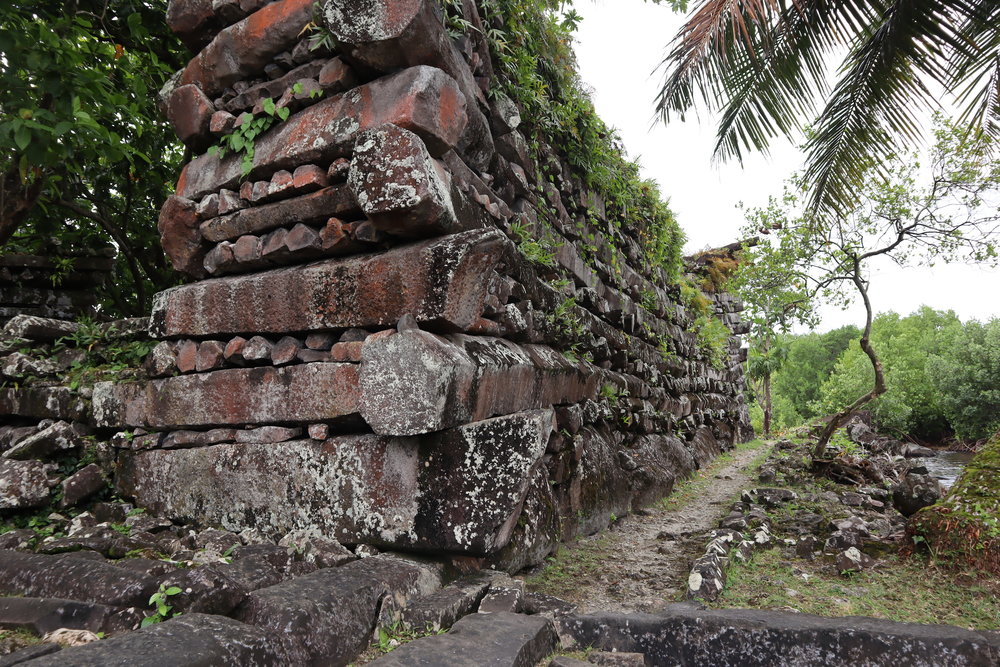
Nan Madol – Stonework
The ruins of Nan Madol are shaped like a giant layer cake made out of stone. Three concentric squares emerge out of the calm shallow waters on this side of Pohnpei, each with their own pathway along the edge surrounding the “layer” above it. A central set of stairs, beginning from the point at which you cross the moat, leads up to the central stone altar in the middle of the topmost floor.
This altar was the ceremonial seat of power for Pohnpei’s ruling Saudeleur Dynasty back in the 12th century. It’s from this structure that Pohnpei gets its name – upon (“pohn”) a stone altar (“pei”).
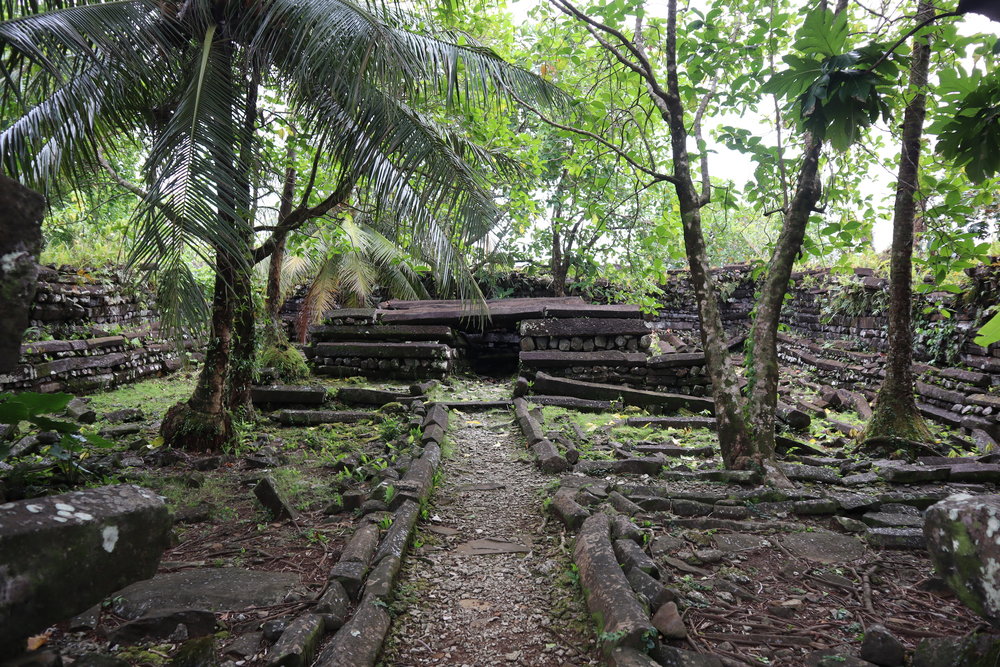
Nan Madol – Central stone altar
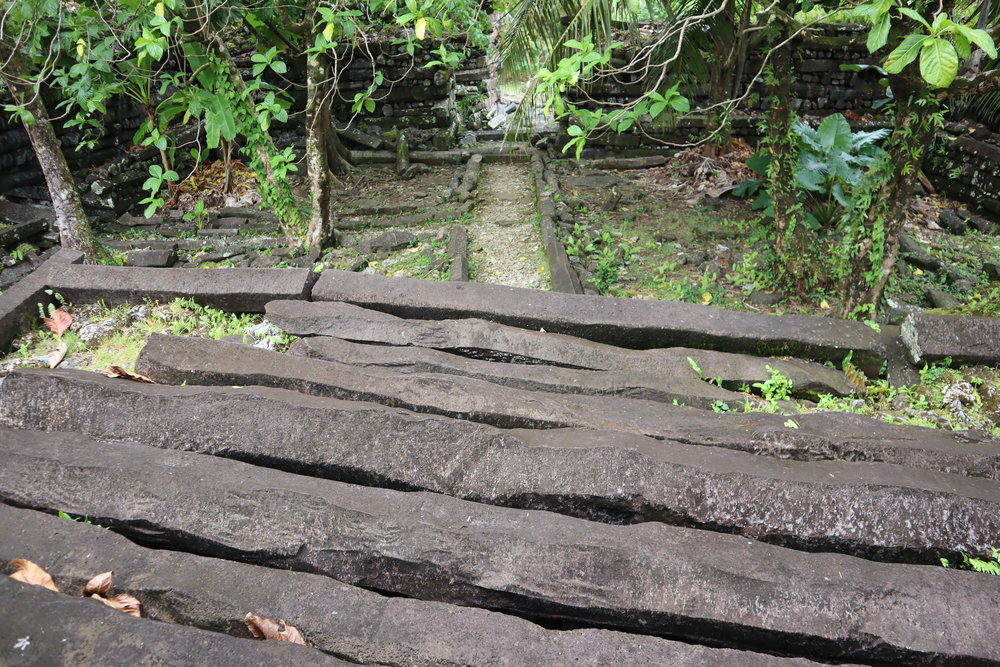
Nan Madol – Atop the central stone altar
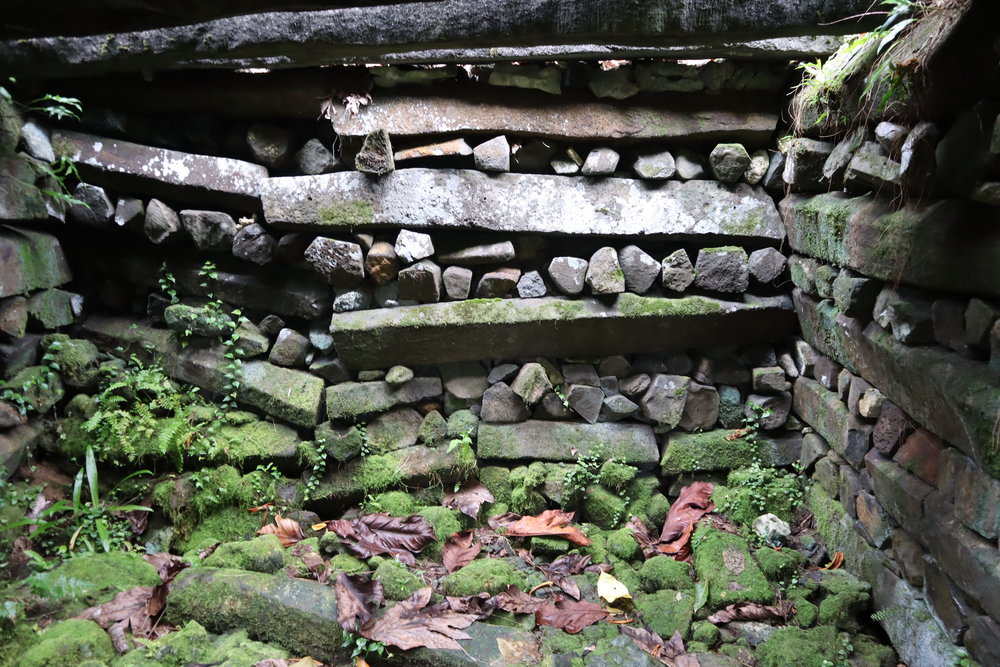
Nan Madol – Inside the central stone altar
What truly captures the imagination about Nan Madol is that no one really knows how these gigantic pieces of stone were moved into place. Archaeologists have never figured out how the ancient islanders were able to construct this city-on-the-sea, which – it’s believed – was home to over 1,000 people during the height of the Saudeleur Dynasty in the 12th and 13th centuries.
Local legend has it that Nan Madol was built with the powers of levitation of two Pohnpeian twin brothers, and who am I to dispute that?
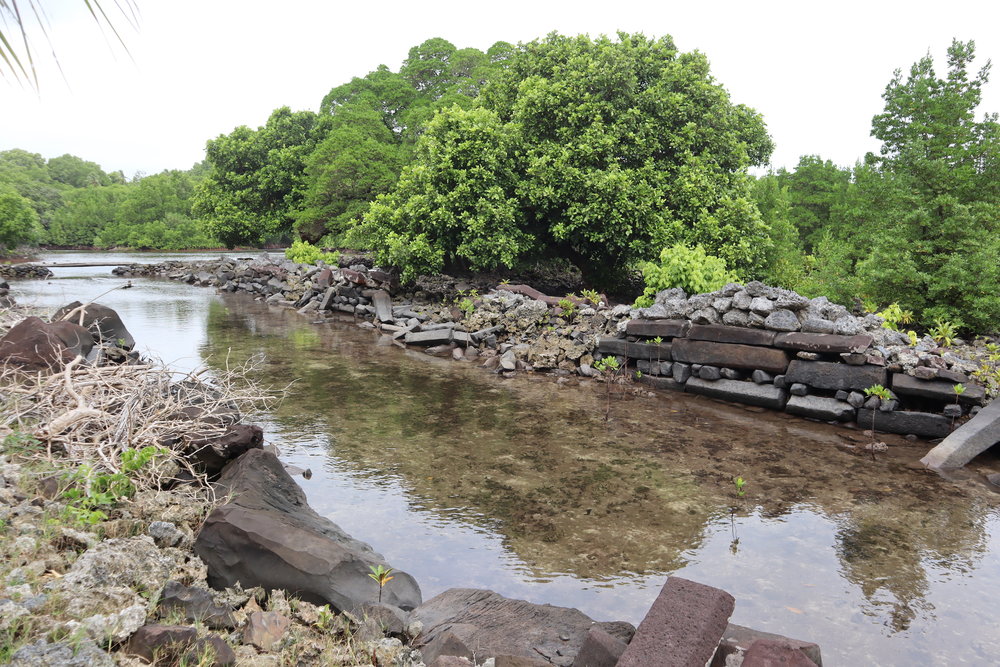
Nan Madol – Ancient city on the water
With the wind whistling through the stone walls and the gentle waves of the water in the background, I couldn’t help but feel a truly palpable sense of mysticism about the place. I sat on top of the stone altar and – as I had done so many times along this trip – took a moment to simply look all around me and contemplate my surroundings.
I could’ve spent all day soaking in that feeling, but alas, the journey had to continue.
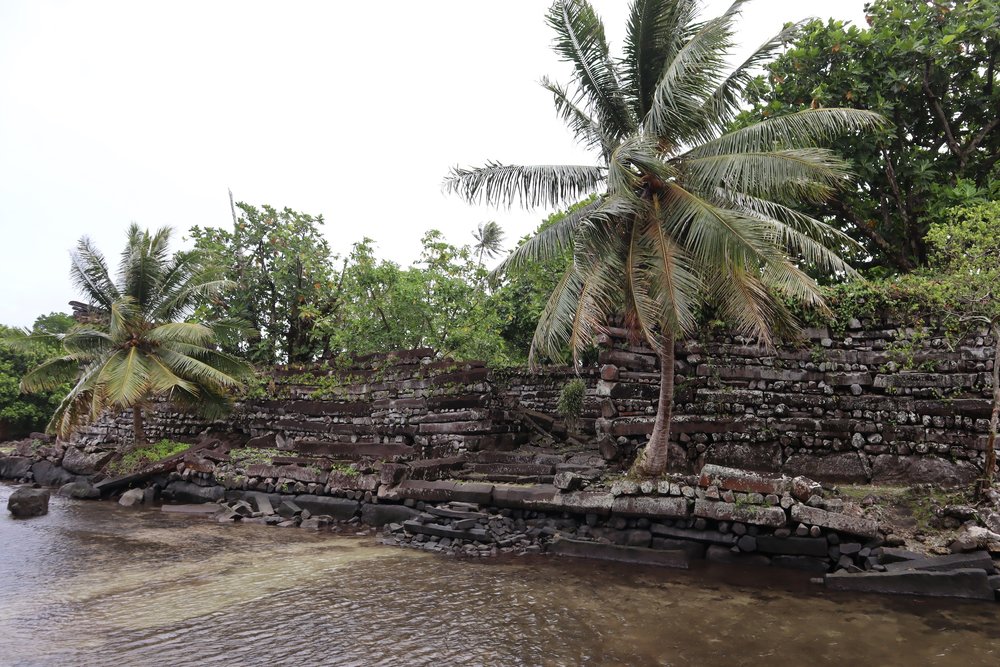
Back across the channel…
With one final, longing glance back at Nan Madol, I pulled up my shorts, waded back across the channel, and began my journey back up the hill and into town.
My driver would be taking me all the way back to Pohnpei International Airport, where I’d be saying goodbye to the FSM as I embarked on the “true” Island Hopper – United Flight 155 – through Kosrae, Kwajalein, and Majuro, all the way to Honolulu.
Conclusion
In contrast to Chuuk, Pohnpei was very much a joy to discover. It’s by far the most developed of the four constituent states of the FSM, and there’s plenty of things to do to keep the visitor occupied: from wreck diving in the surrounding waters, to hiking the island’s mountains and looking for WWII-era armaments, to the otherworldly ruins of Nan Madol on the island’s eastern shores.
If, at some point in the future, I had a few days to spare when travelling between North America and Asia, I’d love to return to Pohnpei with Jessy in tow and spend a few days recapturing these memories from my brief time on the island. And if you’re looking for an exciting new adventure in a less-travelled part of the world, then Pohnpei would be a spot that I’d highly recommend.


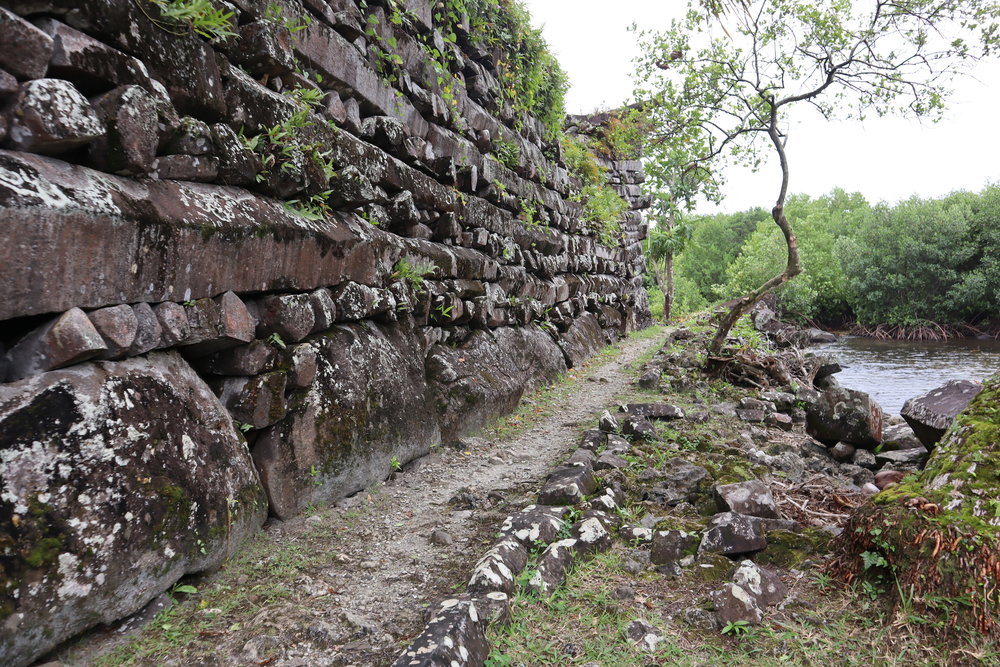
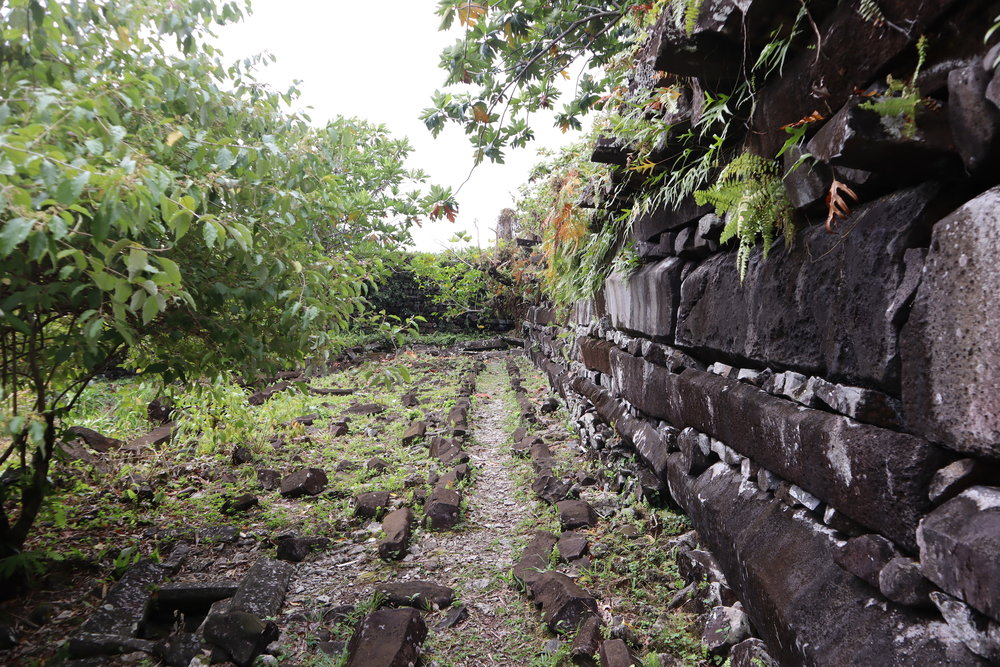
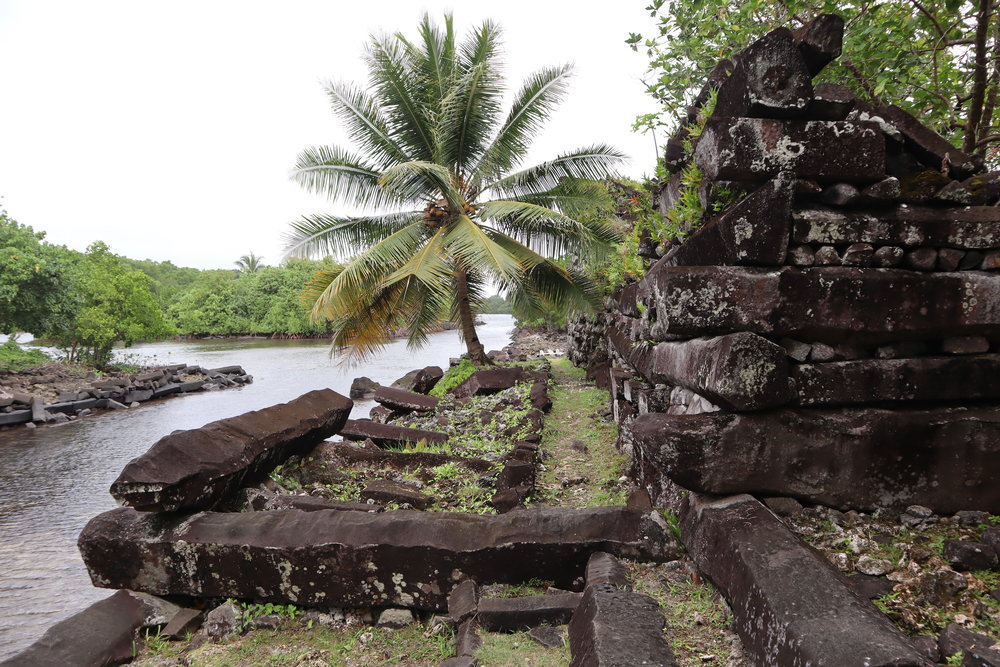
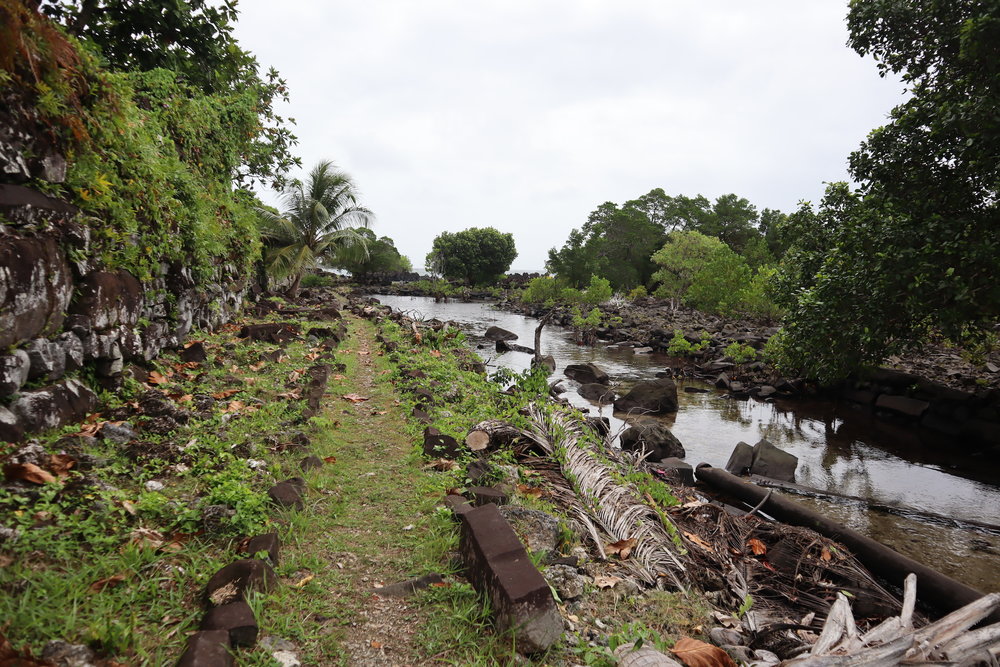









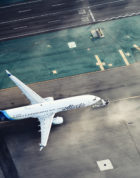
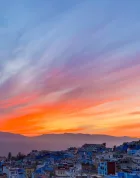


Thank you for your positive highlights of Pohnpei. Next time you come visit, stop by at the Tourism Office and meet the staff there to give you even more list of adventures you will never forget. Palikir pass offers surfing season which caught the World’s surf champions returning to Pohnpei year after year, with the amount of rain we have contribute to our lush jungle with over 40 rivers and waterfalls. and boy do we have more. Hope to see you next time.
What is the current status with respect to entry requirements/COVID?
Thanks for the comment! Definitely hope to swing through PNI again sometime
soon on the Island Hopper 🙂